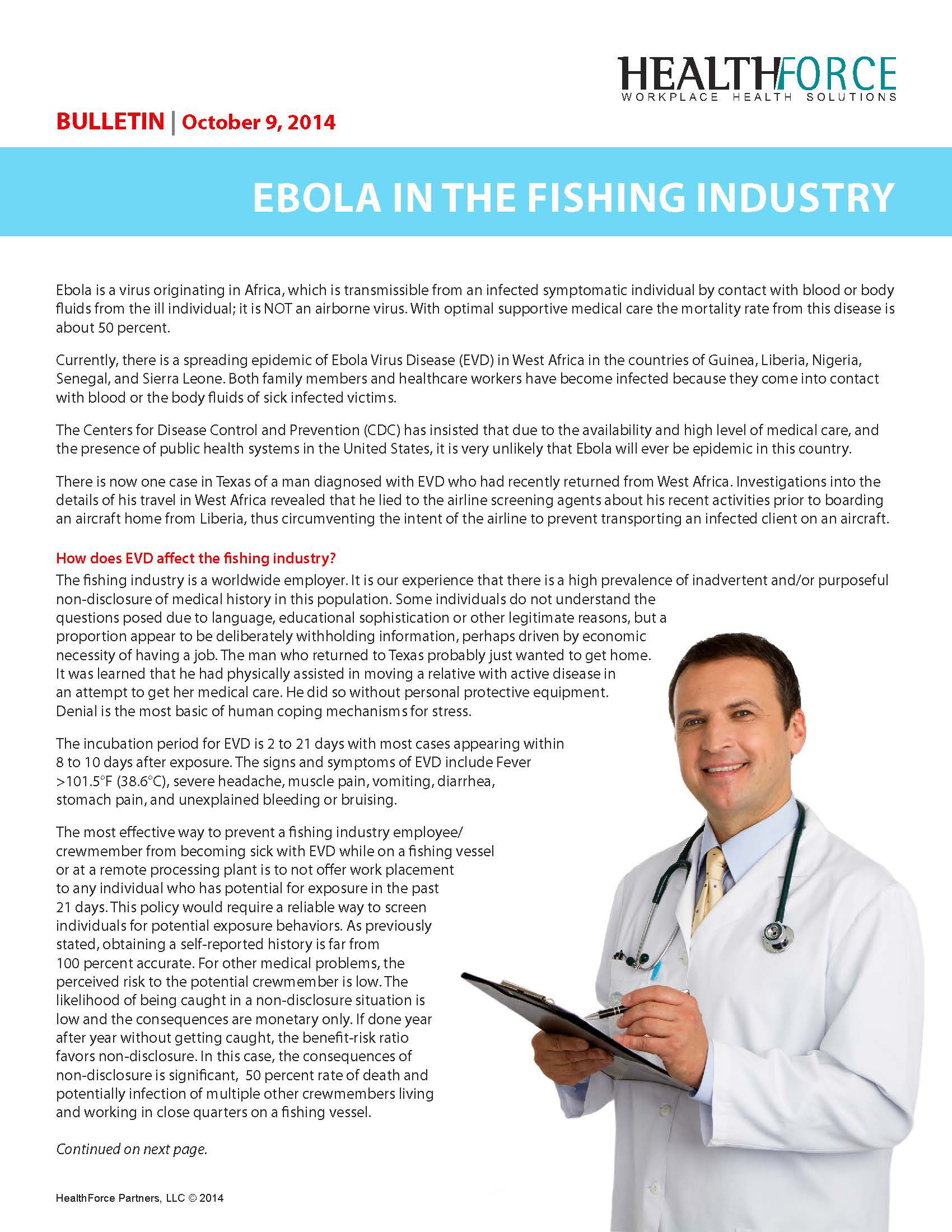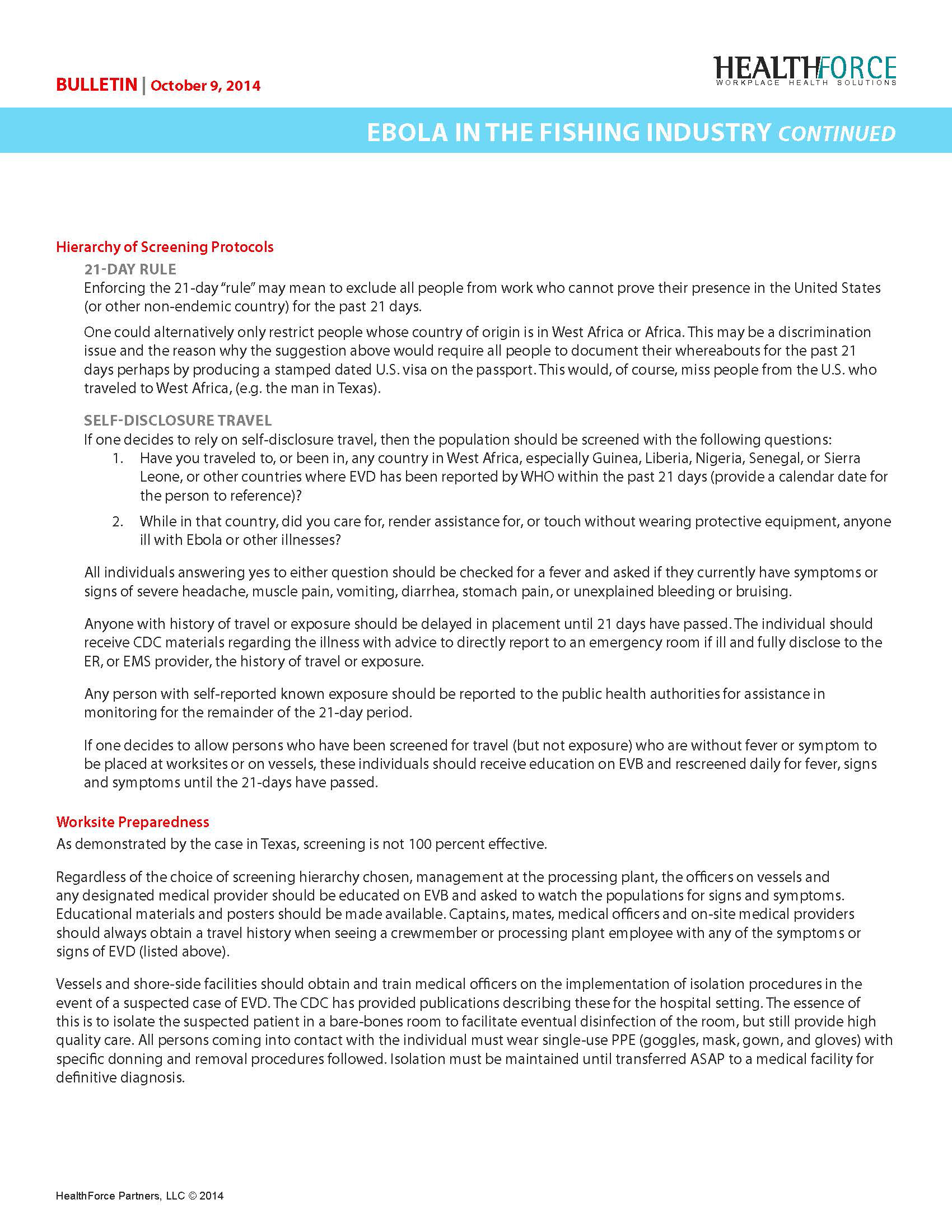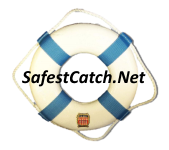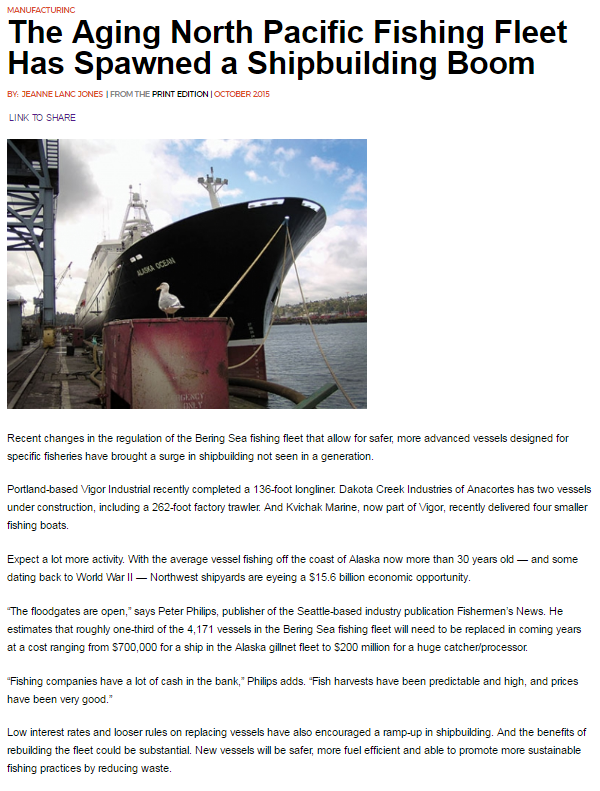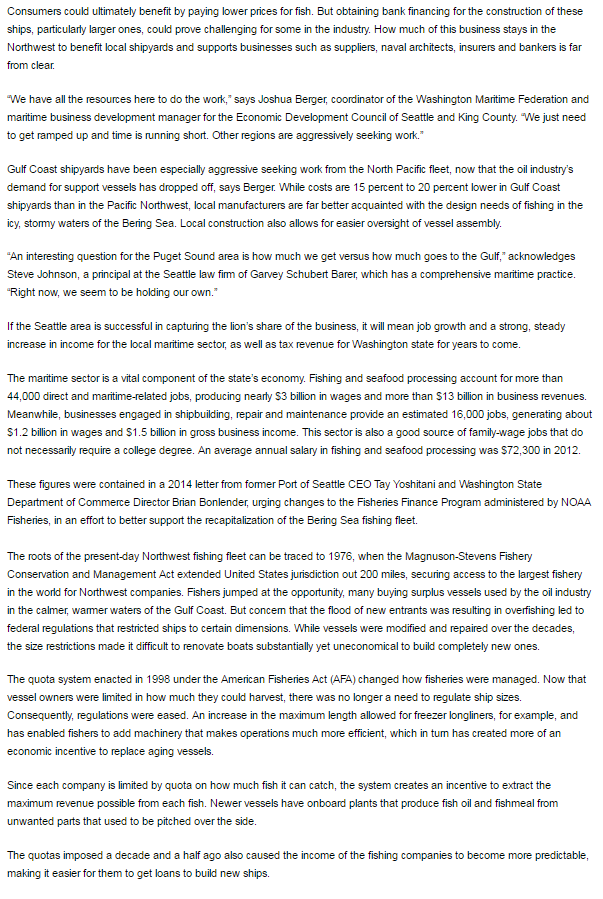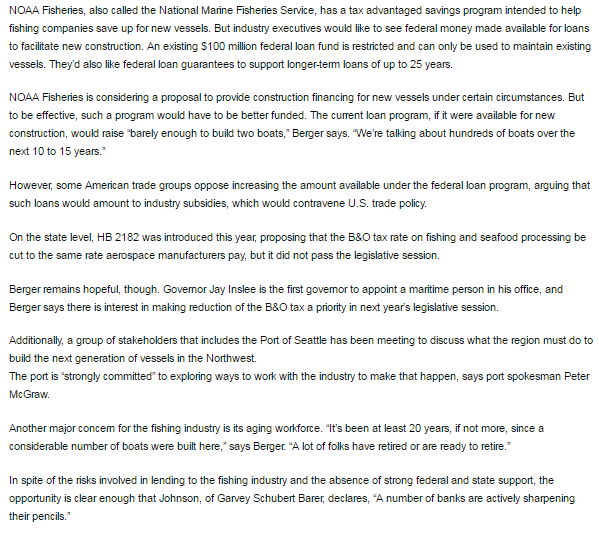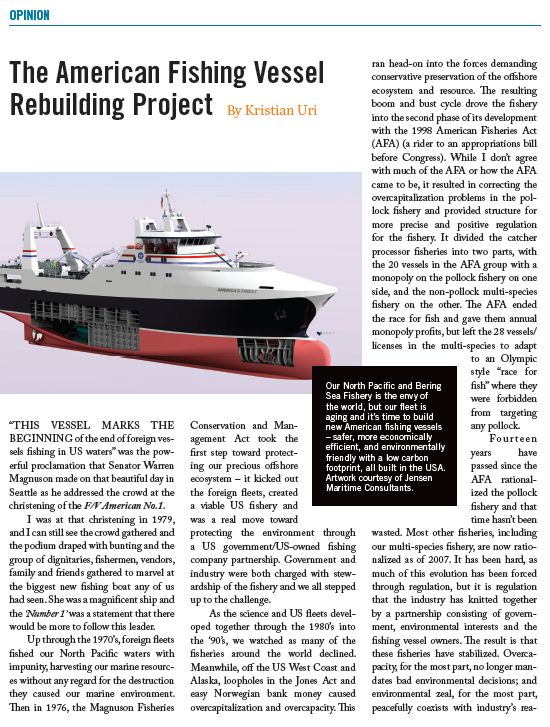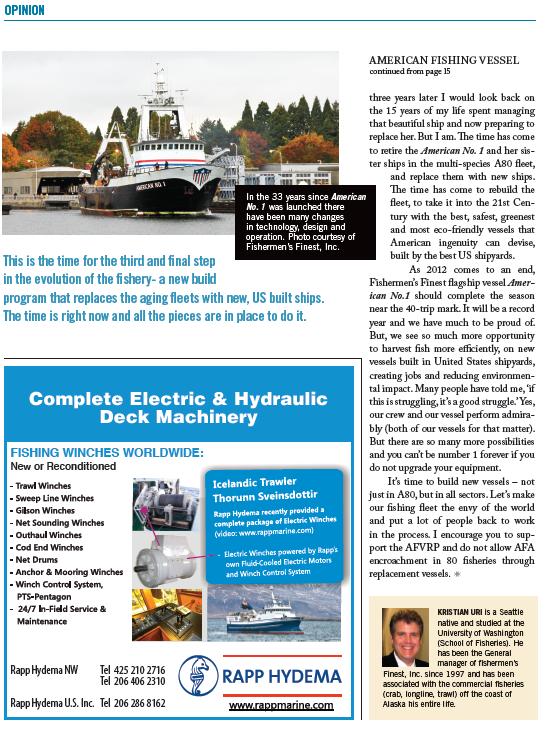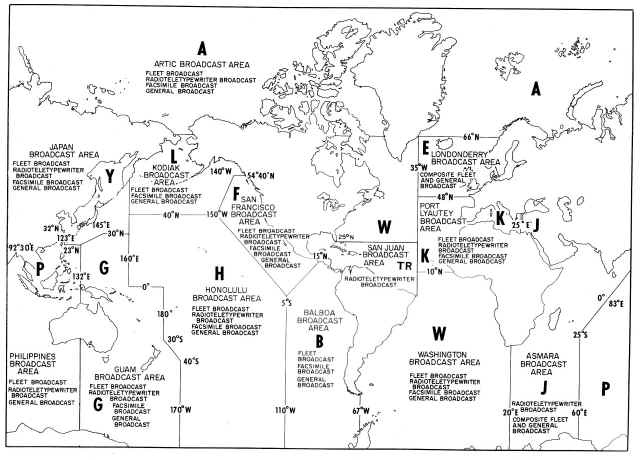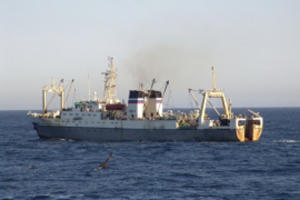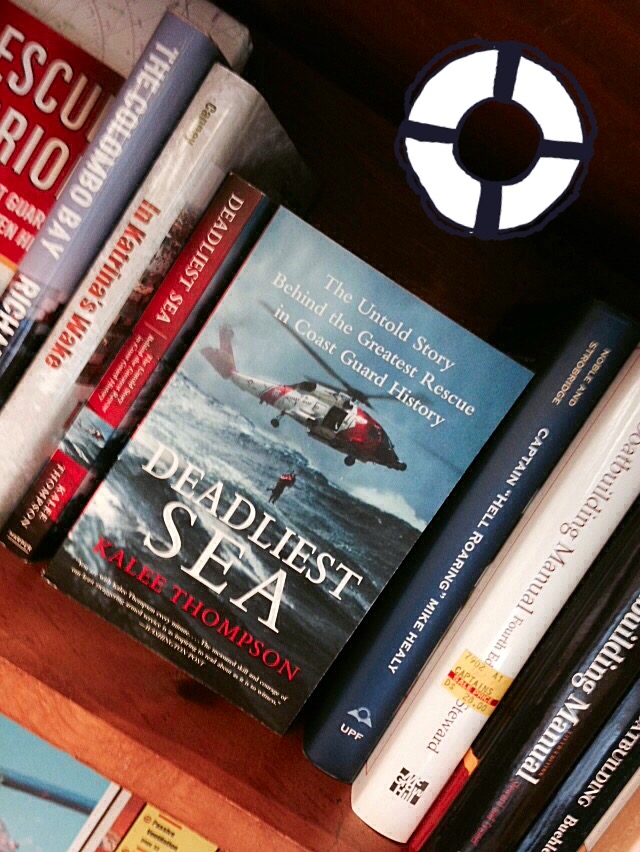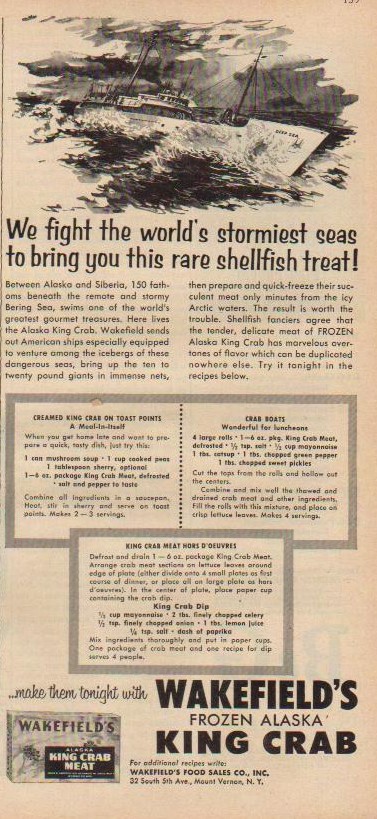About Safest Catch
SafestCatch.net is a web-based community committed to safety at sea and sustainable fisheries; Safety first followed closely by quality seafood production.
In a play on the imfamous Deadliest Catch, it is important to look beyond 'made for TV' and look at the real fishermen who are the true stewards of our Nation's resources.
Services
This site is envisioned as a go to source from one lifelong mariner's perspective to follow the maritime industry of the Pacific Northwest/Alaska and provide timely information on Safety Practices, Real World fishing in the North Pacific & Bering Sea, Training/Educational Links, Sustainable Stewardship of our Nation's resources, and more ~ check back regularly as the industry is 'all consuming' and there undoubtedly will always be something new to report on.
Log Book
Fishermen's Memorial 11/15/2016
SafestCatch.Net ~ Safest Catch dot Net
The Seattle Fishing Community Gathered on Tuesday November 15th to remember those that have gone before us and raise funds at it's annual Dinner Auction. The Seattle Fishermen's Memorial provides a valuable service to the community and we were honored to attend.
The Memorial is a charitable organization devoted to promoting safety in the fishing fleets and easing the emotional and financial burden of surviving family members of fishermen lost at sea. In furtherance of this commitment, the Memorial Board established an educational scholarship fund in 1999 to provide scholarships to eligible family members and other dependents who suffered the tragedy of losing their loved ones to the sea.
The Board's hope is that the scholarships will lessen the financial burden on these families and dependents who may not otherwise achieve their educational goals.
This year's Scholarship Recipients are:
Shelby Henry; Father Kurt Henry
Brian Long; Father Michael Long lost off the Aleutian Challenger
James Long; Father Michael Long lost off the Aleutian Challenger
Michaela Long; Father Michael Long lost off the Aleutian Challenger
Foster Grant Modesette; Father Harry Modesetter F/V Evanick
Lauren Williamson; Father David Williamson F/V Jamie D
For a complete list of the program from this year's event, please see 29th Annual Dinner Auction Program
Deadliest Catch meets Safest Catch ~ real fishermen pursuing safety and sustainability. Link: 29th Annual SFM Auction

A Vessel of Evolution - ARCTIC TRAWLER 1986 by Konrad S. Uri North Pacific Focus / National Fisherman Magazine Summer 2016
It was the Summer of 1986 and we were fishing Greenland Turbot in Seguam Pass with the ARCTIC TRAWLER. I had varied crew aboard the vessel, including longstanding employees, my 20 year old son Kris and his friends from the University of Washington, Matt Emmons a Woodway High School friend included , my youngest son Karl (11 years old), Glenn & Scott Penny (their Mother was co-worker at Boeing with my wife Helen’s sister), former Seattle Sounders Defender Mike England’s son Wayne, and Pat Dedmore fresh out of the California Maritime Academy as First Mate.
It was a great time, fishing was fantastic, and prices were good. This was directly contrary to the previous year when we had been fishing Pollock and times were, well, not so good.
For those that don’t know, the Arctic Trawler (ex SEAFREEZE ATLANTIC) is a historical vessel in the United States. Dubbed the ‘Ship of Fools’ by National Fisherman Magazine back in the 1970’s as the SEAFREEZE ATLANTIC, the vessel was a pioneer as the first retrofitted Factory Trawler to make its way as the ARCTIC TRAWLER (all the way from Norfolk Virginia where it had been mothballed by the failed ‘Ship of Fools’ crew) to the Pacific Cod Fishery of the North Pacific and Bering Sea in 1980.
1986 was really the last ‘good times’ summer aboard the fine vessel. I had half my family aboard, their friends and we were making fine money. Seguam Pass, between Amlia Island and Seguam Island is known for prime fishing grounds and unfortunately a rocky bottom. This made for a good learning opportunity for the University of Washington crew that learned to cut and sew web like pros (read three bar, two bar, two bar … three bar). We had 8 nets aboard and we tore up every tow; the longstanding crew and young College guys had a helluva time keeping up!
My sons were busy, working alongside me, as had been our family tradition dating back to the RAINIER (see my previous articles, Dutch Treat North Pacific Focus Fall 2015 and Bering Birthday North Pacific Focus Summer 2015). Karl at 11 years old was working between the factory and the galley; Kris at 20 was our winch driver and deckhand.
Due to the market conditions at the time, we were targeting Greenland Turbot and packing in an H&G format (Headed and Gutted in 20 kg frozen blocks). This made the factory crew happy as well as it was much simpler than the fillets of Pollock and Cod that we had done in previous years. And the cherry on top of the sundae was the weekly tow of Black Cod (Sable Fish) that upped the weekly revenue considerably.
Unfortunately, the good times would come to an end as the previous year’s downturn during the Pollock fishery had driven home the decision to sell the vessel. Long time General Manager Mike Nordby took the helm at Arctic King and the vessel was converted yet again – this time into a surimi trawler. She later was reflagged into the Soviet Union as the POLARNIY and now has come full circle back to the H&G fishery as the SEAFREEZE ALASKA, currently operated by United States Seafoods (which happens to be part of the Amendment 80 fleet that my son Kris is also active in as GM at Fishermen’s Finest).
Fishing has been my life – we were in this together (family, friends, and friends of family) and worked as if our lives depended on it. Which they did – this was serious business. I am pleased to see many of the people I’ve had the good fortune to work with continue to make a living in the fishing industry. Of course, my children are all currently involved in the industry, Scott Penny is a longline Captain at Clipper Seafoods, Glenn is a deckhand between Pollock C/V’s and A80 trawlers, and Pat Dedmore is an officer aboard American Seafoods’ OCEAN ROVER. There were many others and I hope to write more of the experiences we shared.
When we look back upon the experience of fishing together as a family and in a fleet that treated each other like family, I have nothing but the fondest memories, no matter how hard we were actually working.
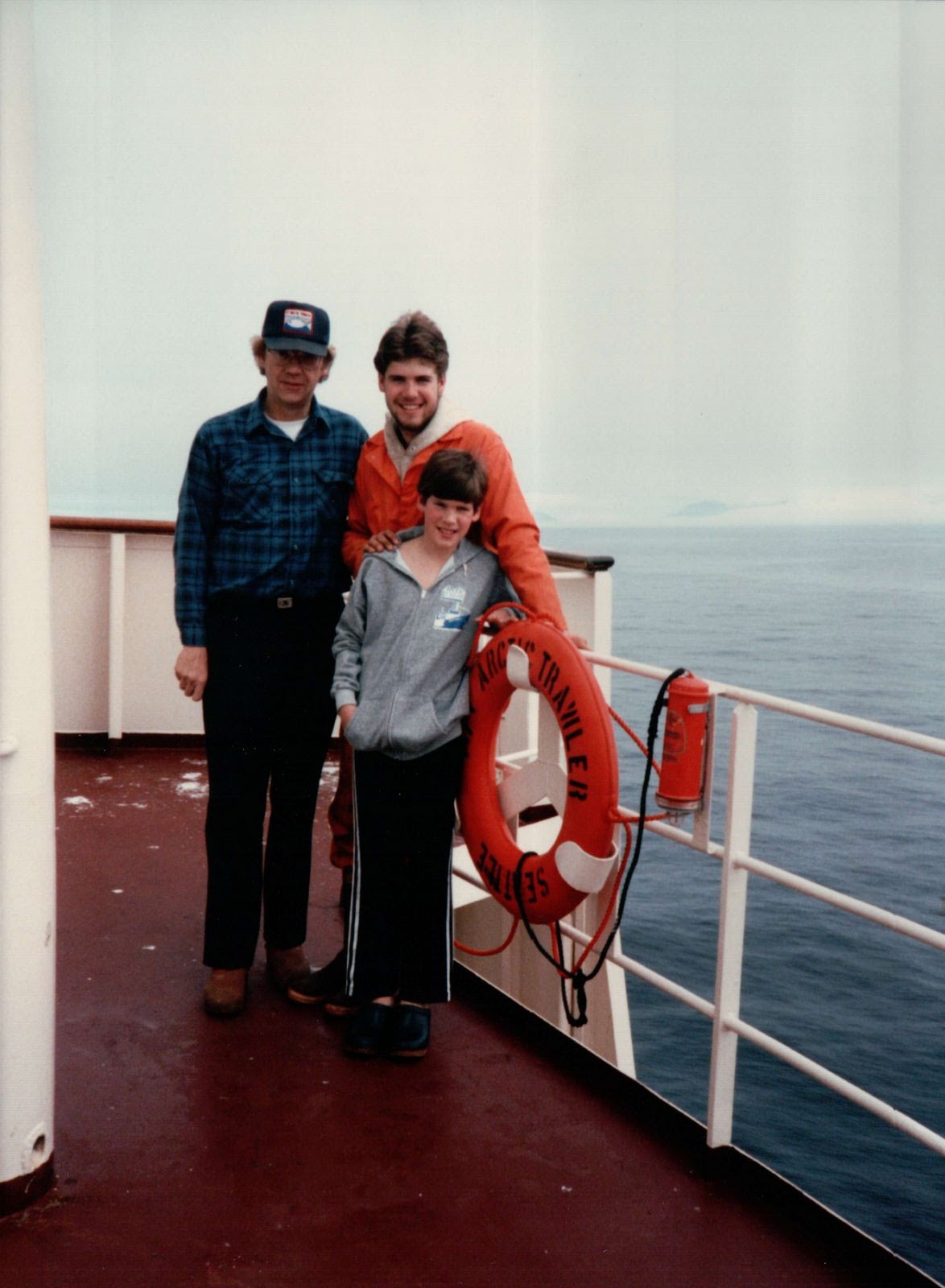
Konrad, Kris, and Karl Uri on the Arctic Trawler in Seguam Pass - Alaska
The Long Haul - A vessel of Evolution - Arctic Trawler 1986 by Konrad S. Uri Permanent Link: Arctic Trawler
Related by Konrad S. Uri
Safestcatch.net ~ Safest Catch dot Net
The Aging North Pacific Fishing Fleet Has Spawned a Shipbuilding Boom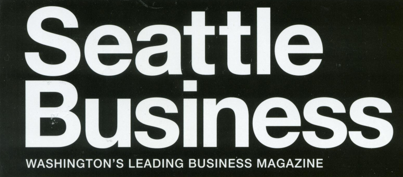
Recent changes in the regulation of the Bering Sea fishing fleet that allow for safer, more advanced vessels designed for specific fisheries have brought a surge in shipbuilding not seen in a generation.
Portland based Vigor Industrial recently completed a 136 foot longliner. Dakota Creek Industries of Anacortes has two vessels under construction, including a 262 foot factory trawler. And Kvichak Marine, now part of Vigor, recently delivered four smaller fishing boats.
Expect a lot more activity. With the average vessel fishing off the coast of Alaska now more than 30 years old — and some dating back to World War II — Northwest shipyards are eyeing a $15.6 billion economic opportunity.
“The floodgates are open,” says Peter Philips, publisher of the Seattle based industry publication Fishermen’s News. He estimates that roughly onethird of the 4,171 vessels in the Bering Sea fishing fleet will need to be replaced in coming years at a cost ranging from $700,000 for a ship in the Alaska gillnet fleet to $200 million for a huge catcher/processor.
“Fishing companies have a lot of cash in the bank,” Philips adds. “Fish harvests have been predictable and high, and prices have been very good.”
Low interest rates and looser rules on replacing vessels have also encouraged a ramp up in shipbuilding. And the benefits of rebuilding the fleet could be substantial. New vessels will be safer, more fuel efficient and able to promote more sustainable fishing practices by reducing waste.
Consumers could ultimately benefit by paying lower prices for fish. But obtaining bank financing for the construction of these ships, particularly larger ones, could prove challenging for some in the industry. How much of this business stays in the Northwest to benefit local shipyards and supports businesses such as suppliers, naval architects, insurers and bankers is far from clear.
“We have all the resources here to do the work,” says Joshua Berger, coordinator of the Washington Maritime Federation and maritime business development manager for the Economic Development Council of Seattle and King County. “We just need to get ramped up and time is running short. Other regions are aggressively seeking work.”
Gulf Coast shipyards have been especially aggressive seeking work from the North Pacific fleet, now that the oil industry’s demand for support vessels has dropped off, says Berger. While costs are 15 percent to 20 percent lower in Gulf Coast shipyards than in the Pacific Northwest, local manufacturers are far better acquainted with the design needs of fishing in the icy, stormy waters of the Bering Sea. Local construction also allows for easier oversight of vessel assembly.
“An interesting question for the Puget Sound area is how much we get versus how much goes to the Gulf,” acknowledges Steve Johnson, a principal at the Seattle law firm of Garvey Schubert Barer, which has a comprehensive maritime practice. “Right now, we seem to be holding our own.”
If the Seattle area is successful in capturing the lion’s share of the business, it will mean job growth and a strong, steady increase in income for the local maritime sector, as well as tax revenue for Washington state for years to come.
The maritime sector is a vital component of the state’s economy. Fishing and seafood processing account for more than 44,000 direct and maritime related jobs, producing nearly $3 billion in wages and more than $13 billion in business revenues. Meanwhile, businesses engaged in shipbuilding, repair and maintenance provide an estimated 16,000 jobs, generating about $1.2 billion in wages and $1.5 billion in gross business income. This sector is also a good source of family wage jobs that do not necessarily require a college degree. An average annual salary in fishing and seafood processing was $72,300 in 2012.
These figures were contained in a 2014 letter from former Port of Seattle CEO Tay Yoshitani and Washington State Department of Commerce Director Brian Bonlender, urging changes to the Fisheries Finance Program administered by NOAA Fisheries, in an effort to better support the recapitalization of the Bering Sea fishing fleet.
The roots of the present day Northwest fishing fleet can be traced to 1976, when the Magnuson Stevens Fishery Conservation and Management Act extended United States jurisdiction out 200 miles, securing access to the largest fishery in the world for Northwest companies. Fishers jumped at the opportunity, many buying surplus vessels used by the oil industry in the calmer, warmer waters of the Gulf Coast. But concern that the flood of new entrants was resulting in overfishing led to federal regulations that restricted ships to certain dimensions. While vessels were modified and repaired over the decades, the size restrictions made it difficult to renovate boats substantially yet uneconomical to build completely new ones.
The quota system enacted in 1998 under the American Fisheries Act (AFA) changed how fisheries were managed. Now that vessel owners were limited in how much they could harvest, there was no longer a need to regulate ship sizes. Consequently, regulations were eased. An increase in the maximum length allowed for freezer longliners, for example, and has enabled fishers to add machinery that makes operations much more efficient, which in turn has created more of an economic incentive to replace aging vessels.
Since each company is limited by quota on how much fish it can catch, the system creates an incentive to extract the maximum revenue possible from each fish. Newer vessels have onboard plants that produce fish oil and fishmeal from unwanted parts that used to be pitched over the side.
The quotas imposed a decade and a half ago also caused the income of the fishing companies to become more predictable, making it easier for them to get loans to build new ships.
Another factor encouraging fishing companies to replace vessels is the tighter safety regulation enacted following the loss of the Arctic Rose and Alaska Ranger. “The cost of keeping those older vessels in operation and upgraded to meet the new Coast Guard standards is very large on an annual basis,” says Johnson. “Do you pay a little more each year to keep the vessel going or simply start over with a more efficient, safer vessel?”
Keith Whittemore, a founding owner of Kvichak Marine Industries and now an EVP of business development at Vigor, which acquired Kvichak earlier this year, expects “very significant” vessel replacement for the North Pacific fleet during the next decade.
Kvichak recently delivered three 32 foot gillnetters that currently fish in Bristol Bay, Alaska, and a 66 foot shallow draft crab and salmon tender that was delivered to the Norton Sound Economic Development Corporation last year. Meanwhile, Blue North Inc. of Seattle has a $37 million, 191 foot freezer longliner under construction at the Dakota Creek Industries shipyard in Anacortes. Dakota Creek is also building a 262foot factory trawler for Kirkland based Fishermen’s Finest. The $75 million vessel is based on a Norwegian design.
“The hardest part was finding local companies with knowledge of state of the art factory trawlers, given we haven’t built once since 1989,” says Kristian Uri, general manager at Fishermen’s Finest. The company chose to go with a foreign design that had been used by other companies. Its other two boats were built in the late 1970s, Uri says.
The perception that Europe has more advanced boat designs is a sore spot for Johan Sperling, a vice president at Jensen Naval Architects & Marine Engineers in Seattle.
“There’s nothing that Europe is doing that we are not doing,” Sperling asserts. “It just happens that we haven’t done it on a fishing vessel because we haven’t built any fishing vessels in 20 years.”
Some of the technology, such as filleting machines, might be new, but Sperling says this is simply equipment the architects need to include in their designs.
While rebuilding the fleet is a big economic opportunity, the financing can be challenging, especially for larger, more complex vessels that can cost hundreds of millions of dollars to build. Industry executives would like access to longerterm loans to make it easier to repay debt.
“Fifteen years is a very long loan in our business,” says Kenny Down, CEO of Blue North. “Banks just haven’t come up with a sophisticated enough package to deal with us. We could use three vessels; we found financing for one.”
Blue North hopes to start building a second ship by early next year, but, says Down, “It is difficult without some sort of safety net in place — such as a federal loan guarantee program — to find conventional financing to support that.”
Because the industry is a complex one, loans must be designed to fit the particular needs and capabilities of each business, says Wells Fargo SVP Eric Mauer. And with owners spending hundreds of thousands to millions of dollars to maintain their vessels, it can be challenging for them to save money for a new one. Some companies may not have enough set aside, notes Brian Reisenauer, a U.S. Bank vice president and relationship manager who specializes in serving the seafood industry.
“Banks expect some skin in the game from the owners,” Reisenauer says.
NOAA Fisheries, also called the National Marine Fisheries Service, has a tax advantaged savings program intended to help fishing companies save up for new vessels. But industry executives would like to see federal money made available for loans to facilitate new construction. An existing $100 million federal loan fund is restricted and can only be used to maintain existing vessels. They’d also like federal loan guarantees to support longer term loans of up to 25 years.
NOAA Fisheries is considering a proposal to provide construction financing for new vessels under certain circumstances. But to be effective, such a program would have to be better funded. The current loan program, if it were available for new construction, would raise “barely enough to build two boats,” Berger says. “We’re talking about hundreds of boats over the next 10 to 15 years.”
However, some American trade groups oppose increasing the amount available under the federal loan program, arguing that such loans would amount to industry subsidies, which would contravene U.S. trade policy.
On the state level, HB 2182 was introduced this year, proposing that the B&O tax rate on fishing and seafood processing be cut to the same rate aerospace manufacturers pay, but it did not pass the legislative session.
Berger remains hopeful, though. Governor Jay Inslee is the first governor to appoint a maritime person in his office, and Berger says there is interest in making reduction of the B&O tax a priority in next year’s legislative session.
Additionally, a group of stakeholders that includes the Port of Seattle has been meeting to discuss what the region must do to build the next generation of vessels in the Northwest.
The port is “strongly committed” to exploring ways to work with the industry to make that happen, says port spokesman Peter McGraw.
Another major concern for the fishing industry is its aging workforce. “It’s been at least 20 years, if not more, since a considerable number of boats were built here,” says Berger. “A lot of folks have retired or are ready to retire.”
In spite of the risks involved in lending to the fishing industry and the absence of strong federal and state support, the opportunity is clear enough that Johnson, of Garvey Schubert Barer, declares, “A number of banks are actively sharpening their pencils.”
Make way for American No.1 to lead to America’s Finest Permanent Link: Shipbuilding Boom
Safestcatch.net ~ Safest Catch dot Net
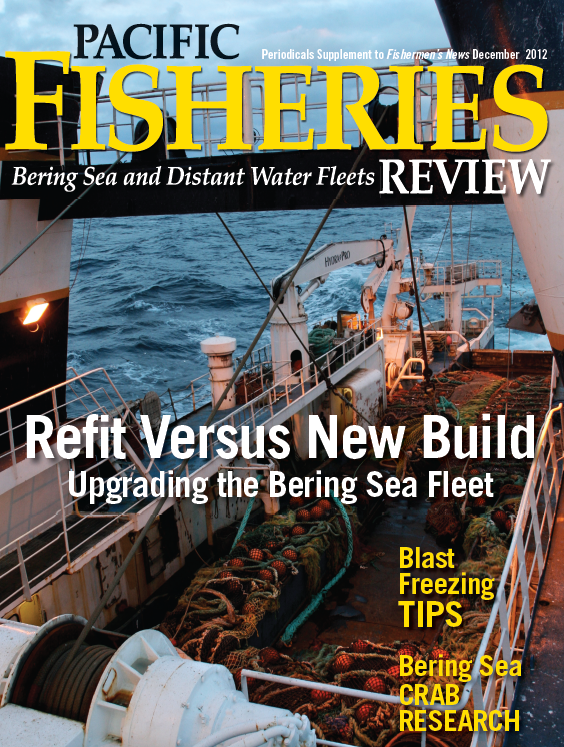
American Fishing Vessel Rebuilding Project by Kristian Uri - Pacific Fisheries Review December 2012
“THIS VESSEL marks the beginning of the end of foreign vessels fishing in US waters” was the powerful proclamation that Senator Warren Magnuson made on that beautiful day in Seattle as he addressed the crowd at the christening of the F/V AMERICAN No.1.
I was at that christening in 1979 and I can still see the crowd gathered and podium draped with bunting and the group of dignitaries, fishermen, vendors, family and friends gathered to marvel at the biggest new fishing boat any of us had seen. She was a magnificent ship and the ‘Number 1’ was a statement that there would be more to follow this leader.
Up through the 1970’s, foreign fleets fished our North Pacific waters with impunity, harvesting our marine resources without any regard for the destruction they caused our marine environment. Then in 1976, the Magnuson Fisheries Conservation and Management Act took the first step towards protecting our precious offshore ecosystem – it kicked out the foreign fleets, created a viable US fishery and was a real move towards protecting the environment through a US government – US owned fishing company partnership. Government and industry were both charged with stewardship of the fishery and we all stepped up to the challenge.
As the science and US fleets developed together through the 1980’s into the ‘90’s, we watched as many of the fisheries around the world declined. Meanwhile off the US West Coast and Alaska, loopholes in the Jones Act and easy Norwegian bank money caused overcapitalization and overcapacity. This ran head on into the forces demanding conservative preservation of the offshore ecosystem and resource. The resulting boom and bust cycle drove the fishery into the second phase of its development with the 1998 American Fisheries Act (a rider to an appropriations bill before Congress). While I don’t agree with much of the AFA or how the AFA came to be, it resulted in correcting the overcapitalization problems in the pollock fishery and provided structure for more precise and positive regulation for the fishery. It divided the catcher processor fisheries into two parts, 1) the 20 vessels in the AFA group with a monopoly on the pollock fishery one side, and 2) the non-pollock multi-species fishery on the other. The AFA ended the race for fish and gave them annual monopoly profits, but left the 28 vessels/licenses in the multi-species to adapt to an Olympic style “race for fish” where they were forbidden from targeting any pollock.
Fourteen years have passed since the AFA rationalized the pollock fishery and that time hasn’t been wasted. Most other fisheries, including our multi-species fishery, are now rationalize as of 2007. It has been hard, as much of this evolution has been forced through regulation, but it is regulation that the industry has knitted together by a partnership consisting of government, environmental interests and the fishing vessel owners. The result is that these fisheries have stabilized. Overcapacity, for the most part, no longer mandates bad environmental decisions and environmental zeal, for the most part, peacefully coexists with industry’s reasonable best efforts to achieve maximum sustainable, and environmentally sound, economic production from the resource. However the cost of this regulatory effort has been an effective prohibition on replacing the aging vessels, resulting in an unacceptable aging of the fleet. The average age of AFA pollock catcher processor hulls is 38 years and for the multi-species, non-AFA pollock catcher processers, it is just over 32.
This is time for the third and final step on the evolution of the fishery- a new build program that replaces the aging fleets with new, US built ships. The time is right, now and all the pieces are in place to do it. The last regulatory hurdle was solved with Amendment 97 in October, 2012 which, finally, allows the multi-species fleet to replace its vessels. The business models are stabilized after 5 years of rationalization in the multi-species fishery, so owners can prepare the reasonably reliable business forecasts required for taking on the massive new debt. At a time when the economy is demanding jobs, jobs, jobs, a new build program will create thousands of domestic highly skilled, high paying manufacturing jobs in the shipbuilding and offshore equipment sectors. The shipyards, owners and the crews are all ready to get started.
The problem is, however, the banks. While interest rates are at an all-time low and money is cheap for the banks, those advantages have not been passed through to the industry that needs the lending to borrow the money to start the projects that will get the economy going again. So we in the multi-species fishery came up with a solution: the American Fishing Vessel Rebuilding Project, the AFVRP. (See the details at our website, www.fishermensfinest.com)
The main objective of the AFVRP is to allow all fishermen (not just multi-species owners) to have access to long term loans that would encourage all vessel owners to build new vessels, cutting out the banking middlemen and getting the loans to finally flow to where they are needed. The program dovetails nicely with the current consensus in favor of fiscal stimulus to jump start the economy and domestic manufacturing. It’s a win-win-win solution. Sure, there are some who are not excited to see this happen and are trying to kill the new build program in its crib through a new round of regulation they recently initiated at the North Pacific Fisheries Management Council. The AFA pollock monopoly has its sights set on replacing our sector’s 32 year old hulls with their retiring 38 year old hulls instead of new builds. But we are confident that the Council will quickly decide to do what’s clearly best for the fisheries, the crews, the fleets, the shipbuilders and the environment, and the country, even if it does prevent the AFA monopoly from making a few extra bucks profit on top of their existing monopoly profits.
Our North Pacific and Bering Sea Fishery is the envy of the world, but our ships are not. Our fleet is aging and it’s not hard to imagine that in the 33 years since the American No. 1 was launched, there have been a few technology changes in vessel design and operation. Beautiful, state of the art, safe, seaworthy, green foreign vessels are being built in Europe with the support of their governments. We envision new American fishing vessels- safer, more economically efficient, and environmentally friendly with a low carbon footprint, all being built in the USA. The AFVRP will help us achieve our vision and help put the country back to work, rebuilding the fleet and our manufacturing base at the same time.
That day at the Marco yard with Senator Magnuson, I was 13 years old. I never could have imagined that thirty three years later I would look back on the 15 years of my life spent managing that beautiful ship and now preparing to replace her. But I am. The time has come to retire the American No. 1 and her sister ships in the multi-species A80 fleet, and replace them with new ships. The time has come to rebuild the fleet, to take it into the 21st Century with the best, safest, greenest and most eco-friendly vessels that American ingenuity can devise, built by the best US shipyards.
As 2012 comes to an end, Fishermen’s Finest flagship vessel American No.1 should complete the season near the 40 trip mark. It will be a record year and we have much to be proud of. But, we see so much more opportunity to harvest fish more efficiently, on new vessels built in United States shipyards, creating jobs and reducing environmental impact. Many people have told me, ‘if this is struggling, it’s a good struggle.’ Yes, our crew and our vessel perform admirably (both of our vessels for that matter, but as this is an article on the American No.1, I am focusing on her). But there are so many more possibilities and you can’t be number 1 forever if you do not upgrade your equipment.
It’s time to build new vessels – not just in A80, but in all sectors. Let’s make our fishing fleet the envy of the world and put a lot of people back to work in the process. I encourage you to support the AFVRP and do not allow AFA encroachment in A.80 fisheries through replacement vessels.
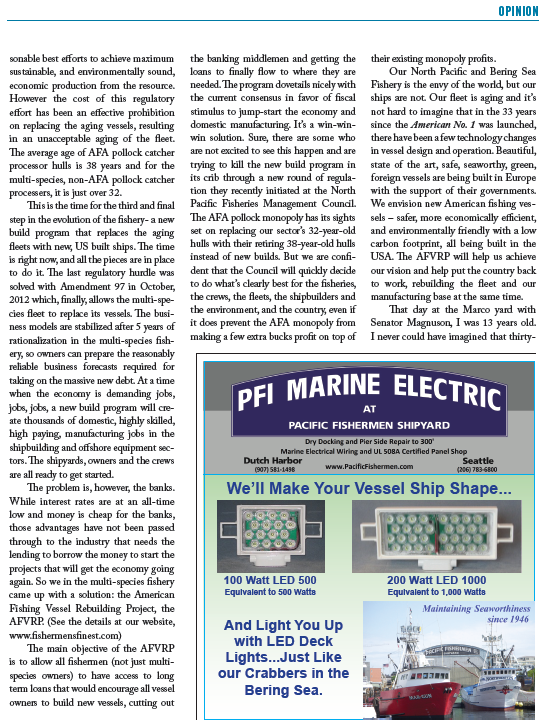
Make way for American No.1 to lead to America’s Finest Permanent Link: AFVRP
Highliner Award 1981 - Konrad Uri
National Fisherman Magazine
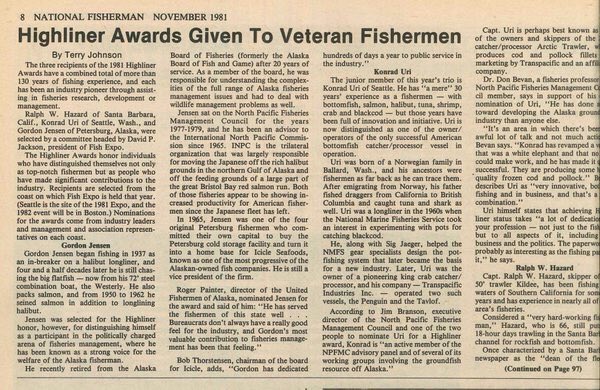
The junior member of this year's trio is Konrad Uri of Seattle. He has "a mere" 30 years of experience as a fisherman -- with bottomfish, salmon, halibut, tuna, shrimp, crab, and blackcod -- but those years have been full of innovation and initiative. Uri is now distinguished as the owner/operator of the only successful American bottomfish catcher/processor vessel in operation.
Uri was born of a Norwegian family in Ballard, Wash., and his ancestors were fishermen as far back as he can trace them. After emigrating from Norway, his father fished draggers from California to British Columbia and caught tuna and shark as well. Uri was a longliner in the 1960's when the National Marine Fisheries Service took an interest in experimenting with pots for catching blackcod.
He, along with Sig Jaeger, helped NMFS gear specialists design the pot-fishing system that later became the basis for a new industry. Later, Uri was the owner of a pioneering king crab catcher/processor, and his company -- Trans Pacific Industries, Inc. -- operated two such vessels, the Pengwin and Pavlof.
According the Jim Branson, executive director of the North Pacific Fisheries Management Council and one of the two people to nominate Uri for a Highliner award, Konrad is "an active member of the NPFMC advisory panel and of several of its working groups involving the groundfish resource off Alaska."
Captain Uri is perhaps best known as the owner and skipper of the catcher/processor Arctic Trawler which produces cod and pollock fillets, marketed by Transpacific and an affiliated company.
Dr. Don Bevan, a fisheries professor at the University of Washington and North Pacific Fishery Management Council Member, says in support of his nomination of Uri, "He has done more toward developing the Alaska groundfish industry than anyone else."
"It's an are in which there's been an awful lot of talk and not much action." Bevan says "Konrad has revamped a vessel that was a white elephant [Seafreeze Atlantic] and that nobody could make work, and he has made it very successful. They are producing some high quality cod and pollock." By describing Uri as "very innovative, both in fishing and in business, and that's a great combination."
Uri himself states that achieving his Highliner status takes "a lot of dedication to your profession -- not just to the fishing but to all aspects of it, including the business and the politics. The paperwork is probably as interesting as the fishing part of it," he says.
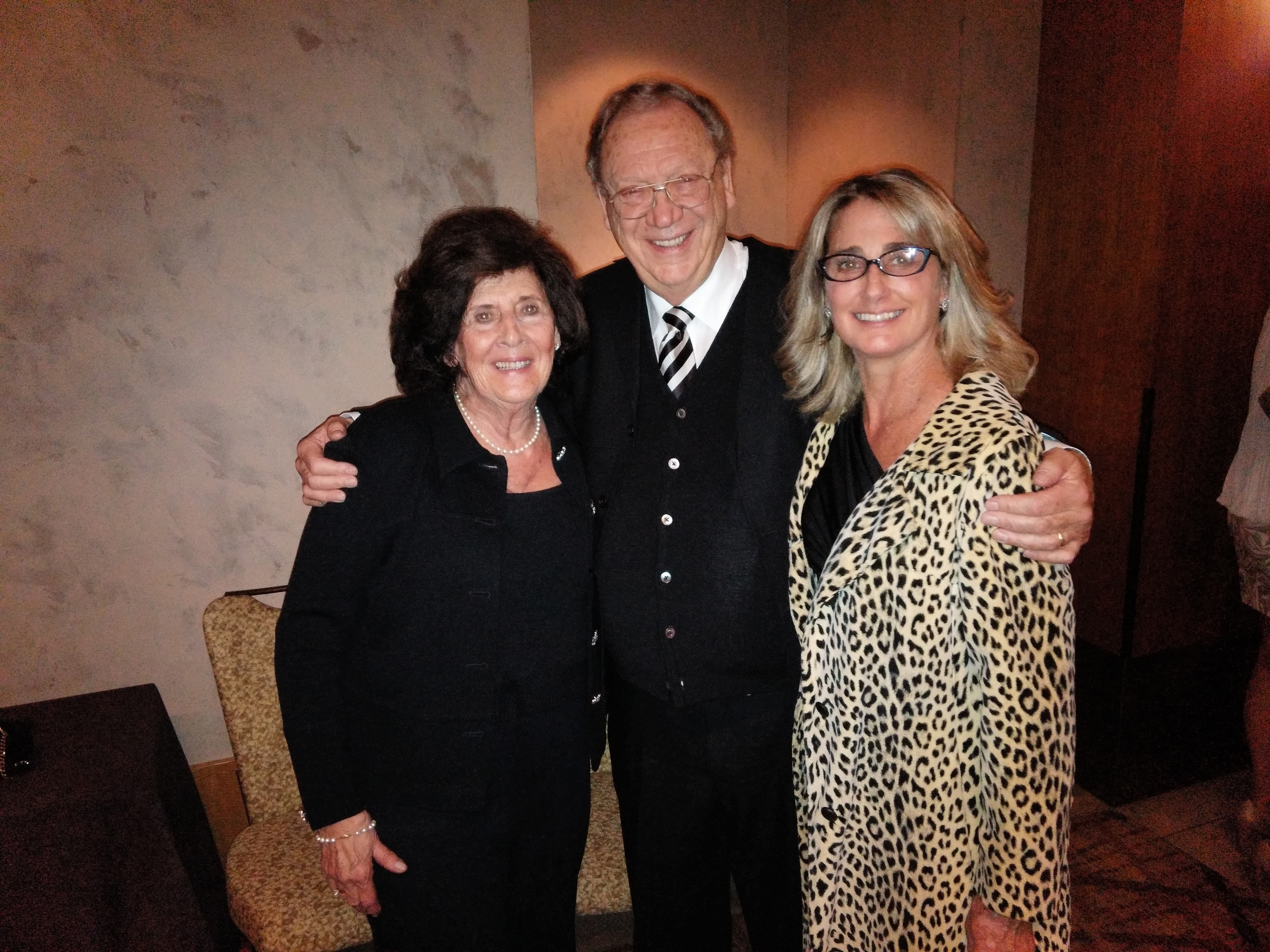
Pictured above are Helen, Konrad, and Beth Ann Uri. Read more about Konrad here: NWFA Person of the year 2011
Safest Catch dot Net ~ SafestCatch.net Permanent Link: Highliner Konrad S. Uri
The Gentle Fisherman - Kaare Ness - January 23, 2015
Trident Seafoods co-founder Kaare Ness passed away on Saturday, January 23rd, I learned from my Facebook page on Sunday. Kaare was born in Karmoy, Norway in 1928 and moved to the United States (starting on the East Coast and ultimately ending up in Ballard - Seattle, Washington).
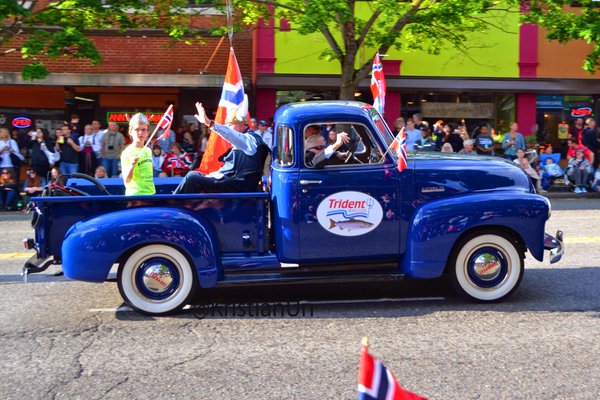
Chuck Bundrant in the back and partner Kaare Ness in the passenger seat - Market Street 2014
Pictured above on the happy occasion of the Syttende Mai parade in Ballard, Kaare was proud of his heritage and beloved by the fishing industry that he played such a large role in developing. With this in mind, the Ness family has requested donations in memory of Kaare be made to:
A quiet man with a warm smile, Kaare even had a song written about him, The Gentle Fisherman (by Aleksander Hauge):
Where the Northern Light
Flash in the night
He was born on an island up North
where the Vikings sailed out from the roughest shore
with long fields and heather moors
From his childhood's land
he was a fisher man
who learned early to fight against the waves
and one day at George's Bank, he nearly was dead
but God took his hand instead
Ref: 'cause he is a man that America needed
with his friend from Tennessee
they built this great fishing company
from Alaska along the Pacific sea
He called his first boat
the Viking Queen
and he is still the King
they know his name and they love this man
from Seattle and up to Akutan
With a heart of gold
and a blessed sole
we will all say thanks to you
You light up the way, for rich and poor
When you opened up your fisherman's door
Ref.
Related Articles:
- KarmøyNytt: The Gentle Fisherman
- KarmøyNytt: Kaare Ness (87) er død
- Twitter.com: Ballard Syttende Mai
- Ballard News Tribune: 17th of May
- Undercurrent News: Trident Mourns the loss of founding partner
- Intrafish.com: Bundrant Ness Partnership defined company
- Intrafish.com: Trident Seafoods founding partner dies
Safest Catch dot Net ~ SafestCatch.net Permanent Link: SafestCatch.Net Kaare Ness
Dutch Treat by Konrad S. Uri - Fall 2015
Originally published in the NORTH PACIFIC FOCUS Fall 2015
Click for PRINT COPY
As I look back upon my fishing career, many fond memories come to mind (especially as I get older and sentimental). They might not have always been easy times fishing in the Bering Sea in the days before internet and satellite phones, let alone GPS, but the one thing the isolation of fishing in such remote locations brought to us was a team spirit to work together and get things done. We had a loran, radar, vhf, and a single sideband radio.
The vessel was our family vessel, RAINIER (110’ Martinolich Crabber) and the year was 1976. We had just completed the Tanner Crab fishery and returned to Dutch Harbor before changing over to fish King Crab.
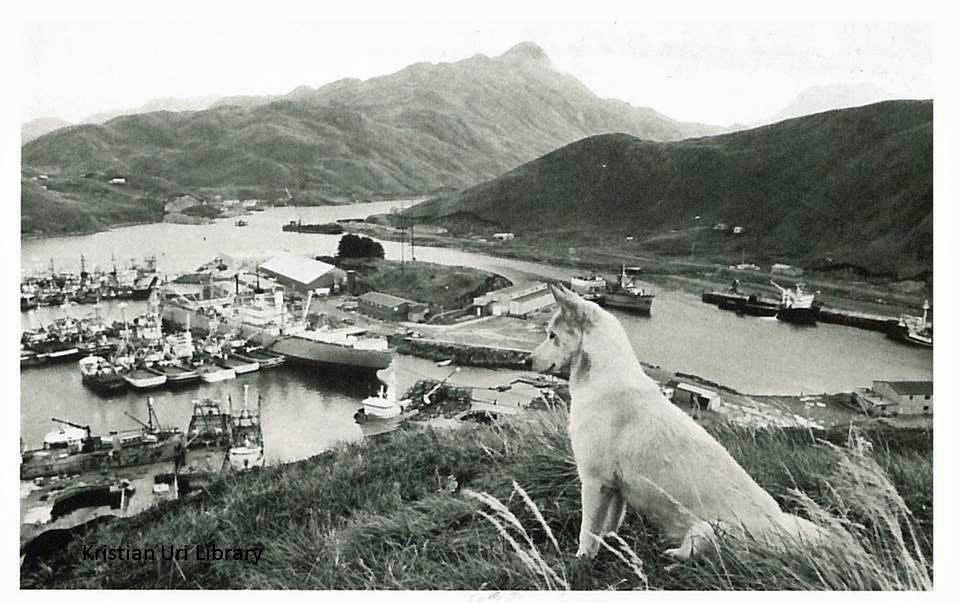
My Uncle Sverre Dagfin Aure, who had come from Norway in 1921 (via the Midwest, arriving Seattle 1930), was a partner in our family West Coast Combination Dragger/Longliner KRISTINE, and more than anything he was the ‘glue’ that held our family together after the untimely death of my Mother (Emma Karoline Aure) when I was 12 and my Father (Konrad Karl Uri) when I was 18 (1953).
Everyone in Ballard referred to Sverre as “Uncle” and unfortunately, his health was failing. I received the call from home that Uncle was sick and I was needed in Seattle. My wife Helen had been aboard the vessel for a trip with our youngest son Karl (6 months old) and the two older brothers were aboard the boat with me for a summer of fishing in the Bering Sea.
It was a two day journey by air to Seattle in those days, with an overnight in Anchorage. Flights were not as readily available as they are today and they were quite expensive. Combine the expense, difficulty, and wanting to spare the kids the pain of the death of a beloved Uncle, it seemed quite natural to leave the boys behind to watch the boat until I could return and head out for King Crab.
Kris was 9, KC was 14 and we were tied up four boats out at the UNISEA (converted Liberty Ship – fish processor) in the inner harbor of Dutch Harbor. I took Kris up with me to meet with Dick Pace in the stern office (location, not demeanor) of the UNISEA and explained the situation.
Would it be okay for the boys to eat in the UNISEA galley with the processing crew while went home to be with Uncle and figure out what we are going to do for him in his last days?
Dick replied, ‘of course, Konrad – glad to help’ and then added half jokingly, ‘just have Kris work a few hours on the shrimp line each day to cover the cost of the meals.’
And that was that; I flew home with Helen and Karl and the rest of the crew. I left instructions with the two kids to keep the day tank full and generator running and be on 4 megs each afternoon at 4 to keep radio schedule with Mom at home – KXY Seattle. It was a different time and phones were scarce.
When I came back up a couple of weeks later, I was pleased to hear from Carl Perovich (F/V VIKING – tied up just inside us at the UNISEA) that Kris had been working away each day on the shrimp line, good to his word. He knew this first hand as one day when the boy came crawling across from the Unisea across three boats out to the RAINIER, he had tried to stop in to say hello to Carl before heading to the wheelhouse to call home on the single sideband radio.
Carl said, ‘the smell hit me before I saw him – shrimp peelings from head to toe and I told him to take a shower before he even thinks of stepping into the galley’ (Carl was known for keeping his vessel impeccably clean).
The boys had many stories to tell of movies in the UNISEA galley, riding dirt bikes, fishing for salmon and shrimp in Captains Bay, etc., etc. Unfortunately Uncle Sverre’s health declined and he passed on August 13, 1976. Ultimately I did bring the boys home for the funeral, but they had the happy memories of a working summer (May – August) aboard the RAINIER and the respect of the UNISEA crew.
Dutch Harbor in the 1970’s was a special place – we were in this together (processors and fishermen) and worked as if our lives depended on it. Which they did – this was serious business. When we look back upon the experience of fishing together as a family and in a fleet that treated each other like family, I have nothing but the fondest memories, no matter how hard we were actually working.
Safest Catch meets Deadliest Catch.
Real Fishermen Pursuing Safety and Sustainable Fisheries. Permanent Link: Dutch Treat by Konrad Uri
Marine Casualty Reporting Updated - October 26, 2015
SafestCatch.Net ~ Safest Catch dot Net
In case you missed it, the United States Coast Guard has issued 'Navigation and Vessel Insepction Circular No. 01-15' dated July 21, 2015. The circular provides guidance to the Mariner for the idenfication and reporting of marine casualties to promote compliance with Title 46, United States Code (U.S.C.)
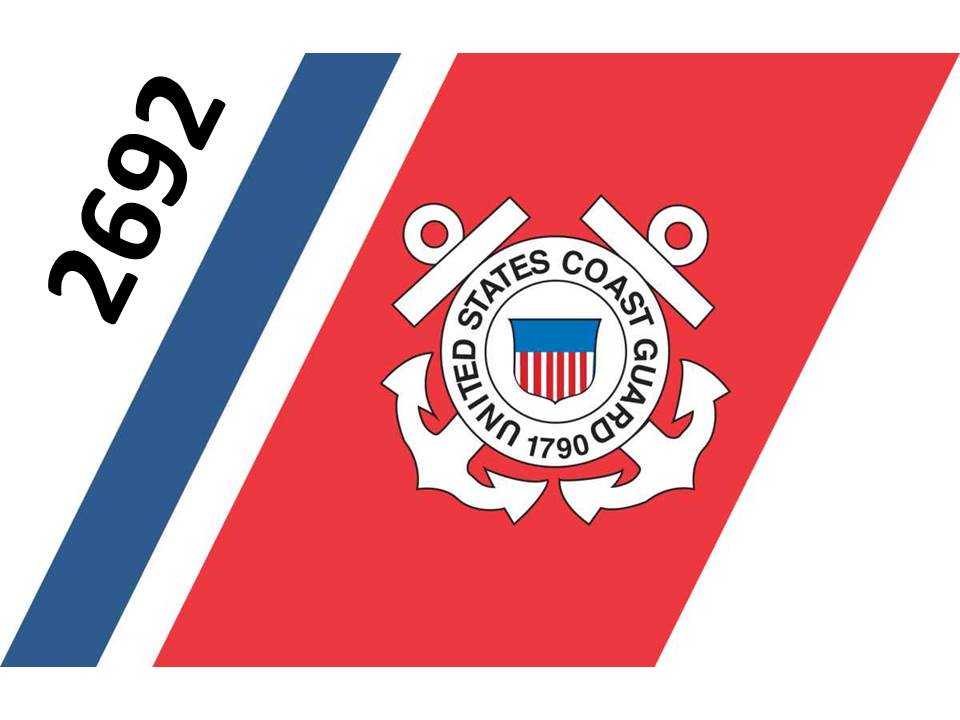
Enclosure (1) to NVIC 01-15: The cicular has a Reporting Marine Casualties table that assists reporting parties to determine whether an occurrence is a reportable marine casualty and, if so, how to comply (i.e., whether or not a USCG form 2692 is needed) with the notification and reporting requirements outlined in 46 CFR part 4.
Safest Catch meets Deadliest Catch.
Real Fishermen Pursuing Safety and Sustainable Fisheries.
Fishermen's Fall Festival - October 3, 2015
SafestCatch.Net ~ Safest Catch dot Net
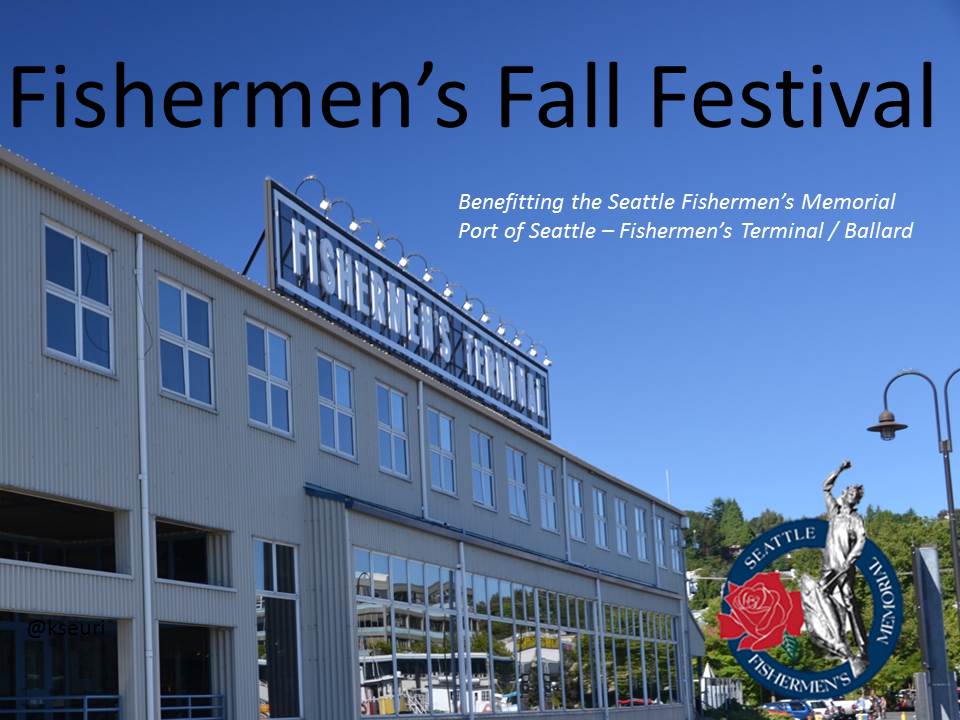
Saturday October 3rd is Fishermen's Fall Festival Day in Fishermen's Terminal (Ballard/Magnolia - Seattle)
The festival is more of a community fair, with music, food, activities - all centered around the maritime industries of the Pacific Northwest. It is an all volunteer event, with proceeds benefitting the Seattle Fishermen's Memorial.
Bring the family (dog friendly!) and enjoy a day on the docks on beautiful Salmon Bay.
Pictures from the event: 2015 Fishermen's Fall Festival #FishFallFest
Safest Catch meets Deadliest Catch.
Real Fishermen Pursuing Safety and Sustainable Fisheries.
THE LONG HAUL: Bering Sea Birthday - September 11, 2015 Permanent Link
SafestCatch.Net ~ Safest Catch dot Net
Captain Konrad Sivert Uri writes in this Summer's National Fisherman Magazine - Bering Sea Birthday
North Pacific Focus - Summer 2015
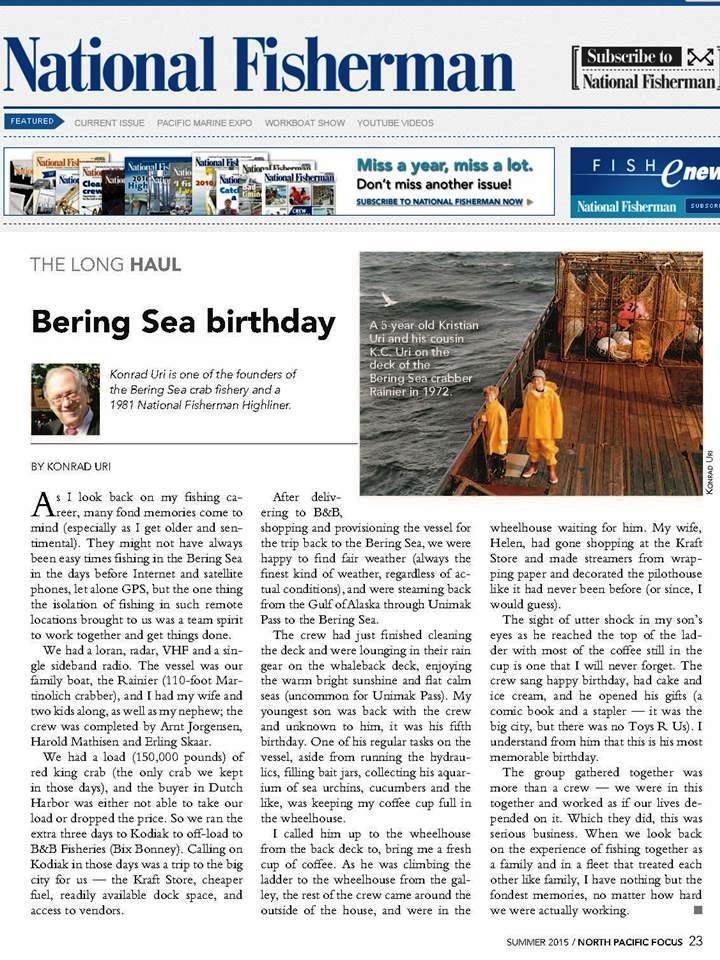
Here's a Link to the story - Bering Sea Birthday AKA 'a trip to Kodiak'
please subscribe to National Fisherman Magazine and support the US Fishing Industry - a valuable industry that supports working/living wage jobs and increases US exports.
Safest Catch meets Deadliest Catch.
Real Fishermen Pursuing Safety and Sustainable Fisheries.
Commercial Fishing Vessel Safety Committee Meeting - Sept 15-16, 2015
SafestCatch.Net ~ Safest Catch dot Net
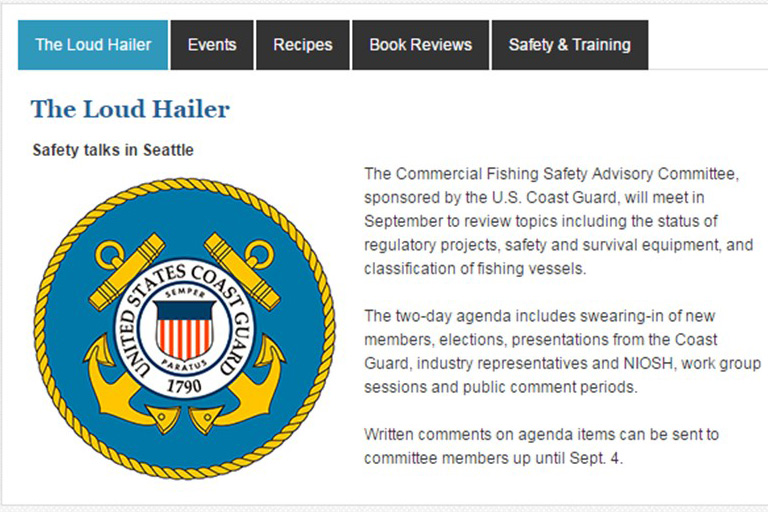
As reported in National Fishermen, The Commercial Fishing Safety Advisory Committee, sponsored by the U.S. Coast Guard, will meet in September to review topics including the status of regulatory projects, safety and survival equipment, and classification of fishing vessels.
The two-day agenda includes swearing-in of new members, elections, presentations from the Coast Guard, industry representatives and NIOSH, work group sessions and public comment periods.
Written comments on agenda items can be sent to committee members up until Sept. 4.
A full agenda can be found online.
When:
Sept. 15-16
8 a.m. - 5 p.m.
The meeting may close early if all business is finished.
Where:
Room 19205
United States District Court House
Seattle, WA
For more information contact Jack Kemerer, alternate designated federal officer of commercial fishing at (202)372–1249 or This email address is being protected from spambots. You need JavaScript enabled to view it..
Safest Catch meets Deadliest Catch.
Real Fishermen Pursuing Safety and Sustainable Fisheries.
COMMSTA Kodiak - July 22, 2015
SafestCatch.Net ~ Safest Catch dot Net
Last week, I had the opportunity to visit Kodiak Alaska ~ an absolutely beautiful place to visit (especially in the Summertime when the sun is high and bright and colors are VIVID)!.
A visit to Kodiak by a person involved with a safety blog wouldn't be complete without a Log Entry on COMMSTA Kodiak
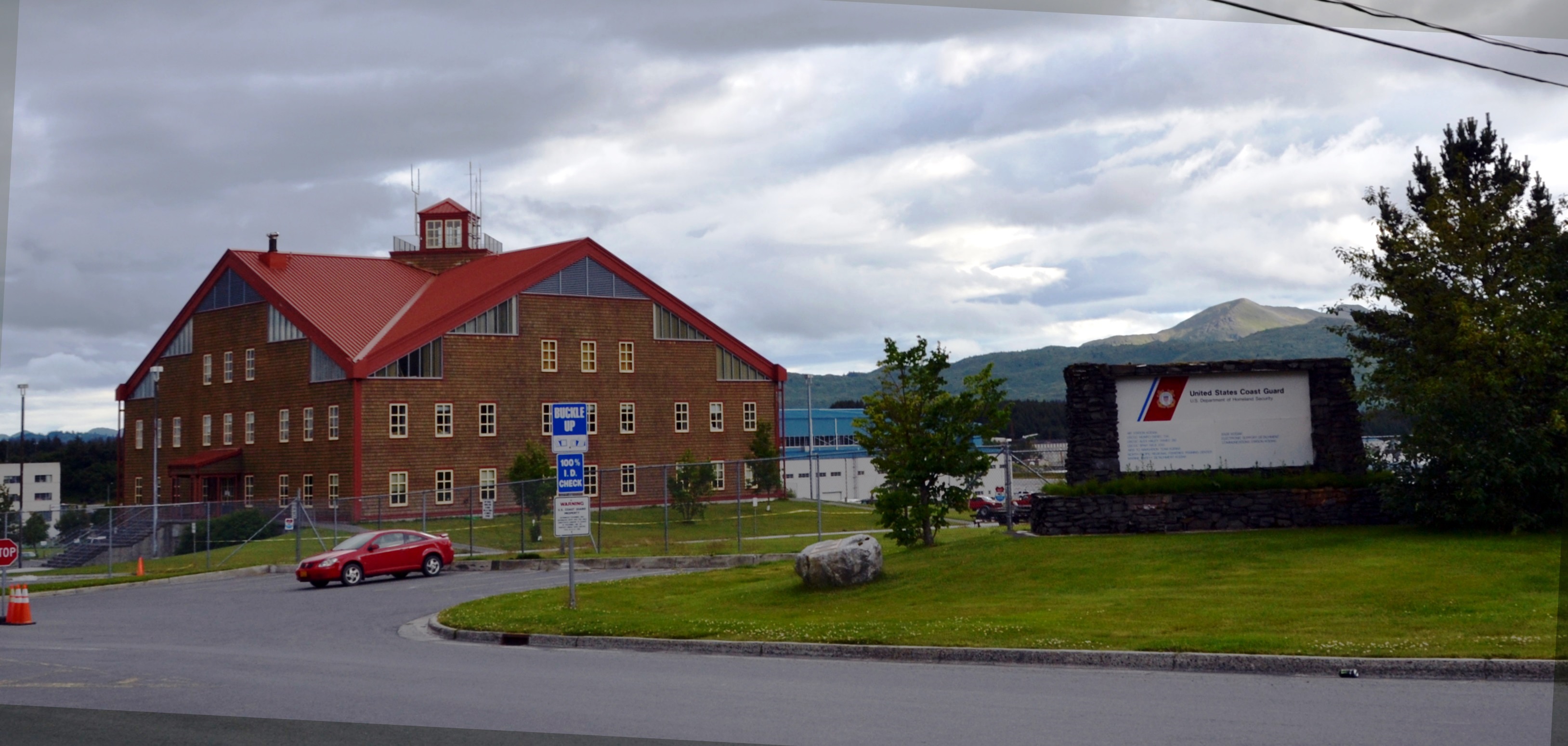
Click link for the official United States Coast Guard Military Blog Commsta Kodiak
And here for my photo album from the visit:
Commanding Officer
LCDR Paul Salerno
Executive Officer
LT Adam Smude
Mission
To provide rapid, reliable and secure communications to the maritime public, US Coast Guard forces, and other Government Agencies (Federal, Local and State).
Vision
We will continually strive to make U. S. Coast Guard Communication Station Kodiak, AK the best long-range communications facility that serves the maritime community. We will earn this reputation by providing the most rapid, reliable and secure communication services available to our customers. Excellent customer service and a highly motivated work force will be our hallmark. Our people will be among the most highly skilled operators, technicians and support personnel in the Coast Guard. We will set these standards by employing a forward-looking strategic management philosophy, meeting the diverse needs of our people, and improving our high quality communications services.
As you can see from the picture below, Commsta Kodiak is responsible for a wide region of the Pacific Ocean
Safest Catch meets Deadliest Catch.
Real Fishermen Pursuing Safety and Sustainable Fisheries.
Alaska Business Forum - June 4, 2015
SafestCatch.Net ~ Safest Catch dot Net
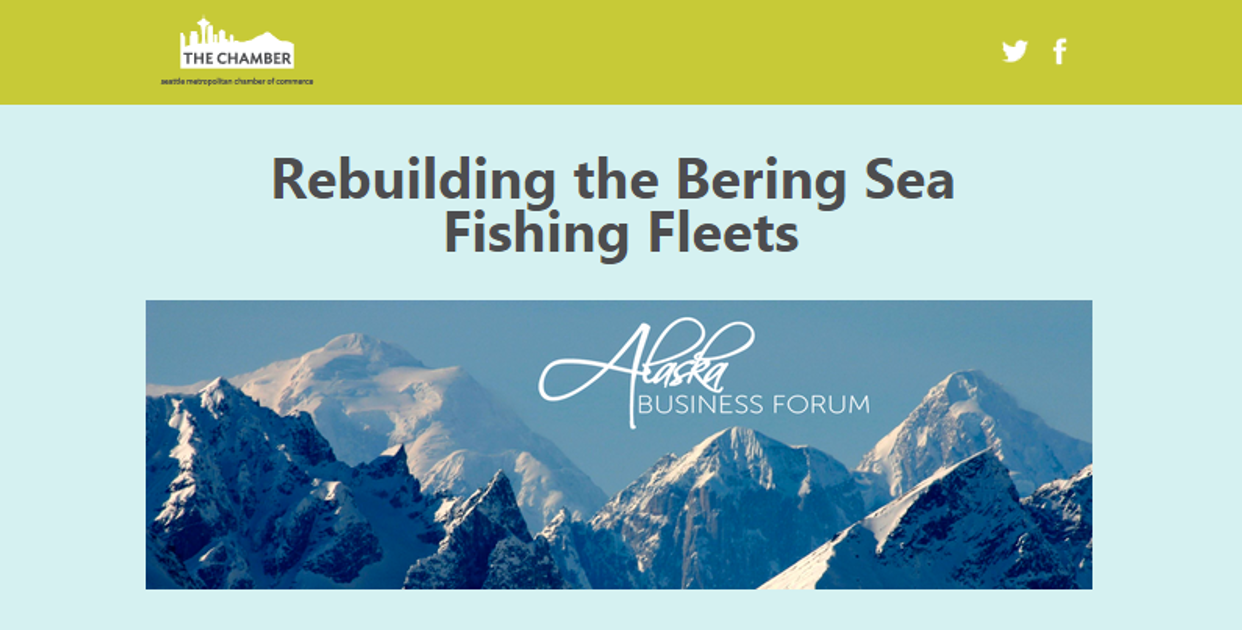
The Seattle Chamber of Commerce held it's Alaska Business Forum at the Microsoft Event Center (1301 5th Avenue - 15th Floor) today and the topic was one that is near and dear to my heart - rebuilding the American/Alaskan Fishing Fleet. The biggest safety improvement we can make in our Industry is to build new vessels. They also come with the side effects/benefits of efficiency, seaworthyness, ecologically friendly, ergonomically/worker friendly, comfortable... The list goes on and on.
We are at the forefront of a new building cycle, the likes of which haven't been seen since the 1970's. The aging vessels that make up our Bering Sea Fleet are starting to be replaced.
At this forum, we heard from Steve Johnson, Esq. Steve is an Owner/Partner at Garvey Shubert Barer and described the age, number of vessels, dollar values and circumstances of the Bering Sea fishing fleets (most of which are based in Seattle).
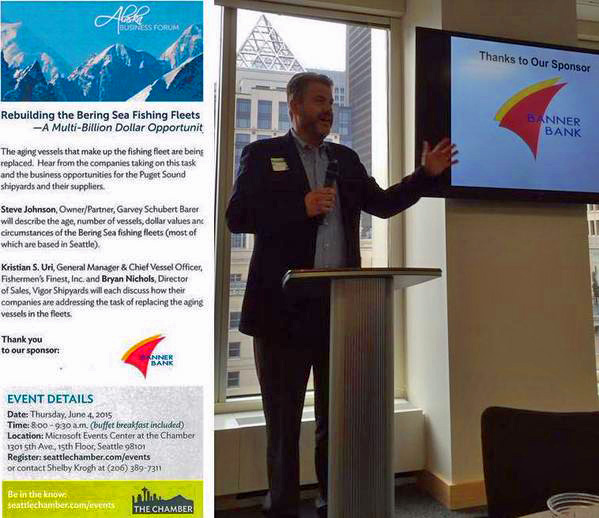 Kristian Uri, General Manager and Chief Vessel Officer of Fishermen's Finest described the process of bringing America's Finest from concept to reality. The 80m (262') vessel cut Evraz DNV (Det Norske Veritas) steel yesterday at Seaport Steel in Seattle; construction will start later this month at Dakota Creek Industries in Anacortes, Washington. It's a long way from the concept which came to mind when seeing the news in Fishing News International that Norway Seafoods (now Havfisk) was replacing their 10 year old vessels with the Gadus Neptune, Gadus Poseidon, and Gadus Njord. The vessels these three were replacing were supperior to any existing vessels in the US Fleet and started them thinking if it can be done in Norway, why not in the United States. Through the process, shipyards, vendors, naval architects, politics, world wide travel all came into play as a decision was made to build an international ST-116 class of vessels. Read more about this project at www.FishFinest.com.
Kristian Uri, General Manager and Chief Vessel Officer of Fishermen's Finest described the process of bringing America's Finest from concept to reality. The 80m (262') vessel cut Evraz DNV (Det Norske Veritas) steel yesterday at Seaport Steel in Seattle; construction will start later this month at Dakota Creek Industries in Anacortes, Washington. It's a long way from the concept which came to mind when seeing the news in Fishing News International that Norway Seafoods (now Havfisk) was replacing their 10 year old vessels with the Gadus Neptune, Gadus Poseidon, and Gadus Njord. The vessels these three were replacing were supperior to any existing vessels in the US Fleet and started them thinking if it can be done in Norway, why not in the United States. Through the process, shipyards, vendors, naval architects, politics, world wide travel all came into play as a decision was made to build an international ST-116 class of vessels. Read more about this project at www.FishFinest.com.
Grant Fosheim brought the Vigor Industrial Oregon - Washington - Alaska shipyard capabilities to the forum and discussed the desire of his firm to build a class of vessels. Harkening back to the Marco (Marine Construction and Design Company) 1970's era of Alaskan crab fishing vessels, Vigor sees the opportunity to work with fishermen to build a class of vessels meeting their needs, capitilizing on the economies of scale afforded by such an approach.
Steve Johnson discussed the table below, as compiled by Peter Phillips and Doug Dixon (Pacific Fisherman Shipyard) shows the Potential Economic Value of Replacement of the Alaskan Fishing Fleet. It truly is a several billion dollar opportunity for American economic activity...
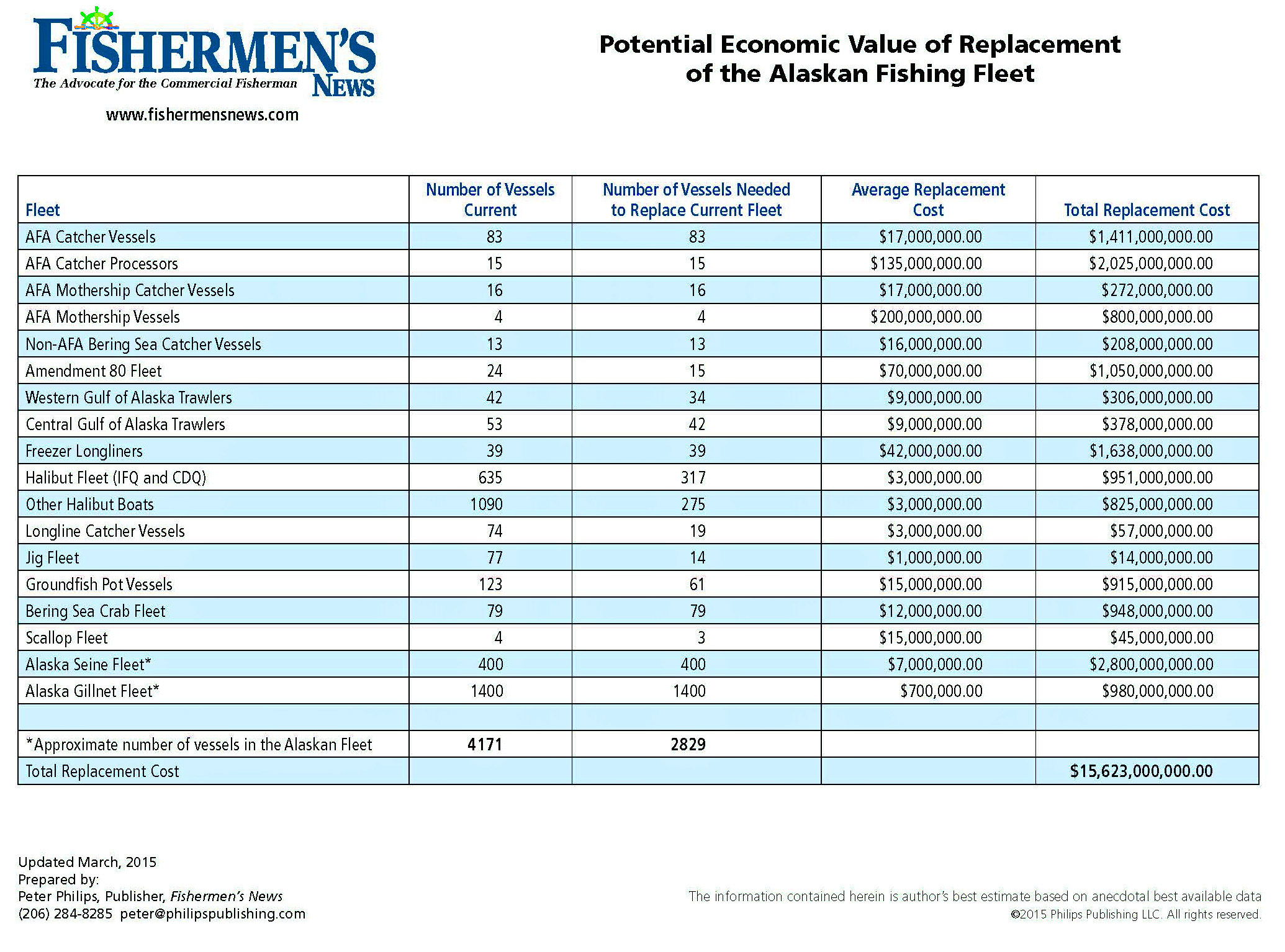
Safest Catch meets Deadliest Catch.
Real Fishermen Pursuing Safety and Sustainable Fisheries.
Seattle Fishermen's Memorial Service - May 3, 2015
SafestCatch.Net ~ Safest Catch dot Net
It was a beautiful sunny Sunday afternoon in Fishermen's Terminal for the annual Seattle Fishermen's Memorial Service. Alan Davis, President of the SFM welcomed the crowd of more than 100 people gathered to remember those who have gone before us. Captain Dave Shoemaker carried the brunt of the load by giving the Invocation, Reading Of Names, Words of Rememberance, and Benediction. He truly did an excellent job and brings a voice of credibility to the cause, as he was involved in the loss of the vessel Galaxy - he knows first hand what it is like to lose someone at sea. CLICK for PICTURES
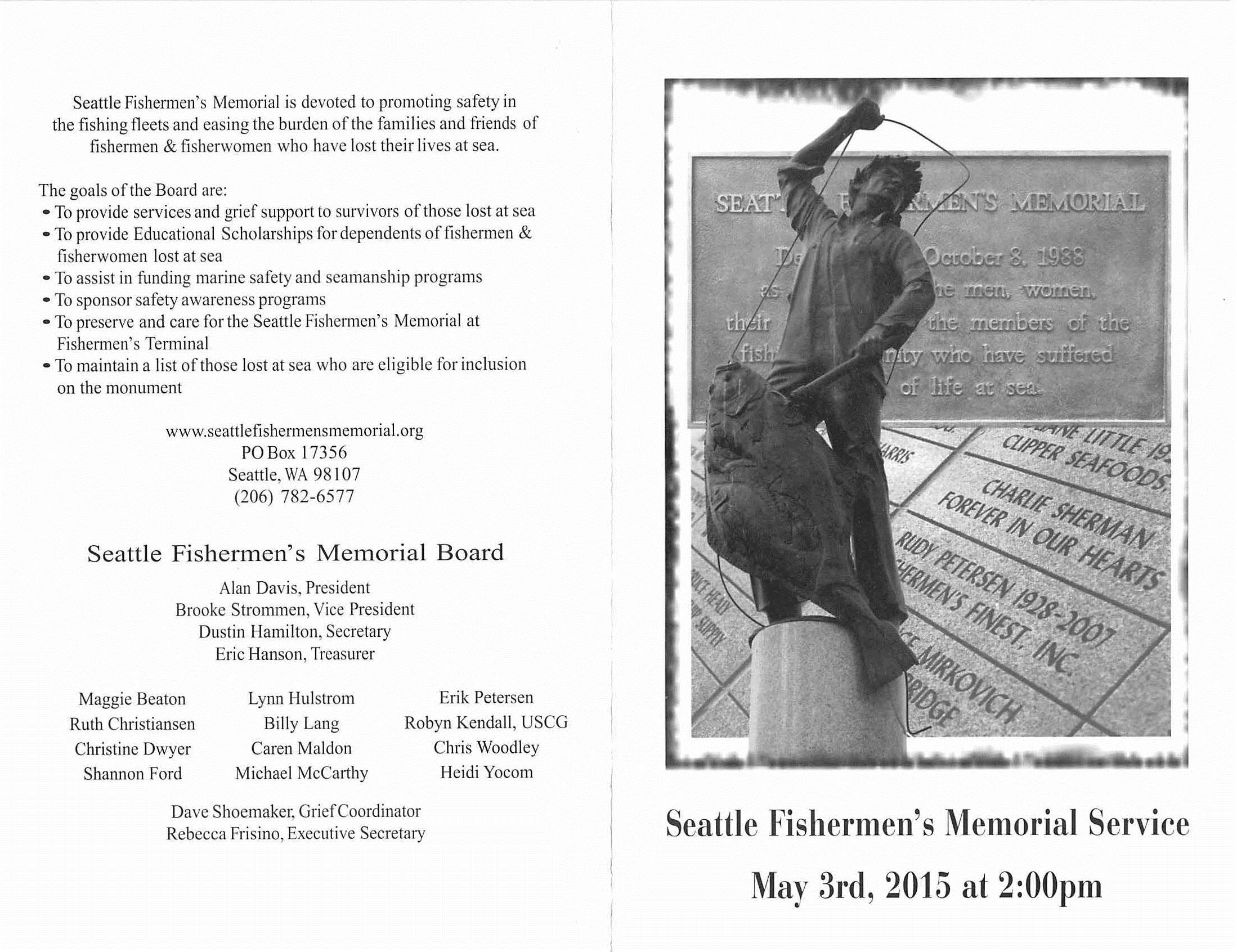
Names added to the memorial this year: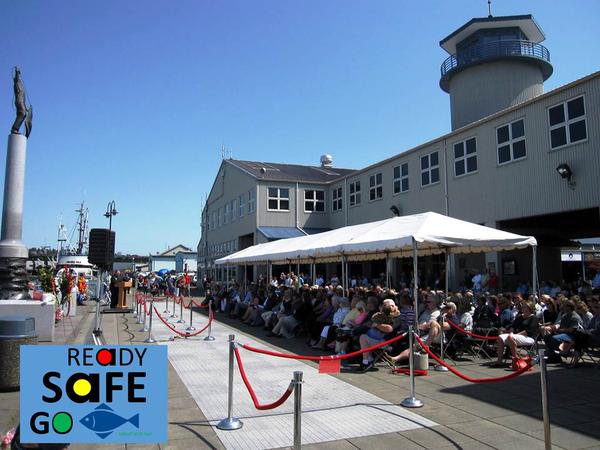
Patrick Thomas Becker
Sean Christopher Beals
Scott Bowlden
Capain Mark C. Fenner
Michael Fish
Stanley J. Hovik
Kerry Lee Knapp
Douglas A. Kristjanson
Kristopher Knutsen
Christopher G. Larson
Captain Harald (Harold) Myrold
Captain Alan Lauritzen
Leif Johan Lorgen
Ronald Lloyd
Tom Medendorp
Arvid Victor Portin
Captain Hand-Jarle Saetre
John J. Sather
Marvin J.E. Stone
Jim Zuanich
We also had the following companies sponsor Memorial Support Tiles:
Coastal Transportation
Johnson Controls Seattle Industrial & Marine
Northlake Shipyard Inc.
Purse Seine Vessel Owner's Association
With famiy and friends, the Seattle Fishermen's Memorial remembers with honor and respect those who have lost their lives at sea.
Safest Catch meets Deadliest Catch.
Real Fishermen Pursuing Safety and Sustainable Fisheries.
Fishing News International - May, 2015
SafestCatch.Net ~ Safest Catch dot Net
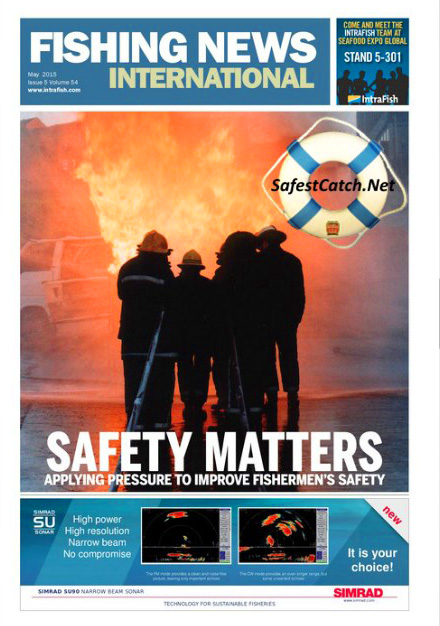
Read the emagazine here: May 2015 Fishing News International
The International Standards for Training, Certification, and Watchkeeping for Seafarers (STCW) are discussed and the importance of such a system is obvious.
This magazine (now an ezine) is my favorite as it shows a world-wide perspective on the Fishing Industry - an industry that unfortunately in the USA we have lagged behind the rest of the world when it comes to new, state of the art, green, efficient, worker-friendly vessels. This is an area that is slowly changing, led in the Pacific Northwest by companies such as the O'Hara Corporation, Blue North, and Fishermen's Finest.
Safest Catch meets Deadliest Catch.
Real Fishermen Pursuing Safety and Sustainable Fisheries.
Deepwater Horizon - April 20, 2015
SafestCatch.Net ~ Safest Catch dot Net
Click for a first hand account from an unidentified person close to the incident that forever changed how we will look at offshore drilling -
As I've said many times, I don't want this site to be only about tragedies, but this one is too big to ignore - 11 lives lost, millions/billions? of damage - some we don't even know today to what extent. Here's a picture of the before and after - but they are nothing compared to the detailed photos and description in the link above.
On April 20, 2015 the oil drilling rig Deepwater Horizon, operating in the Macondo Prospect in the Gulf of Mexico, exploded and sank resulting in the death of 11 workers on the Deepwater Horizon and the largest spill of oil in the history of marine oil drilling operations. Approximately 4.9 billion barrels of oil flowed from the damaged Macondo well over an 87-day period, before it was finally capped on July 15, 2010. On December 15, 2010, the United States filed a complaint in District Court against BP Exploration & Production and several other defendants alleged to be responsible for the spill.
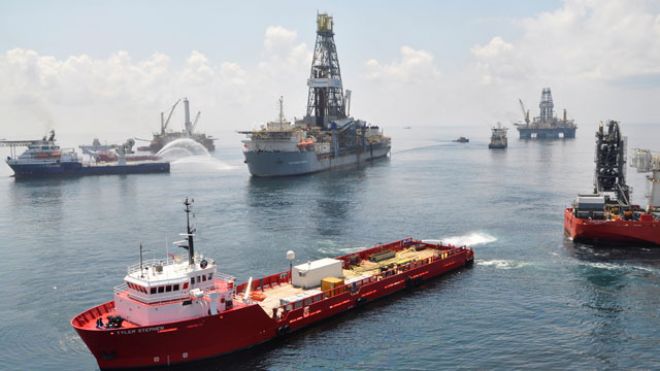
The State of Louisiana has an official Deepwater Horizon Website that compiles and updates information as the case works its way through the system:
MDL 2179 Oil Spill by the Oil Rig "Deepwater Horizon"
An impressive armada to say the least, which makes the following picture that much harder to comprehend:
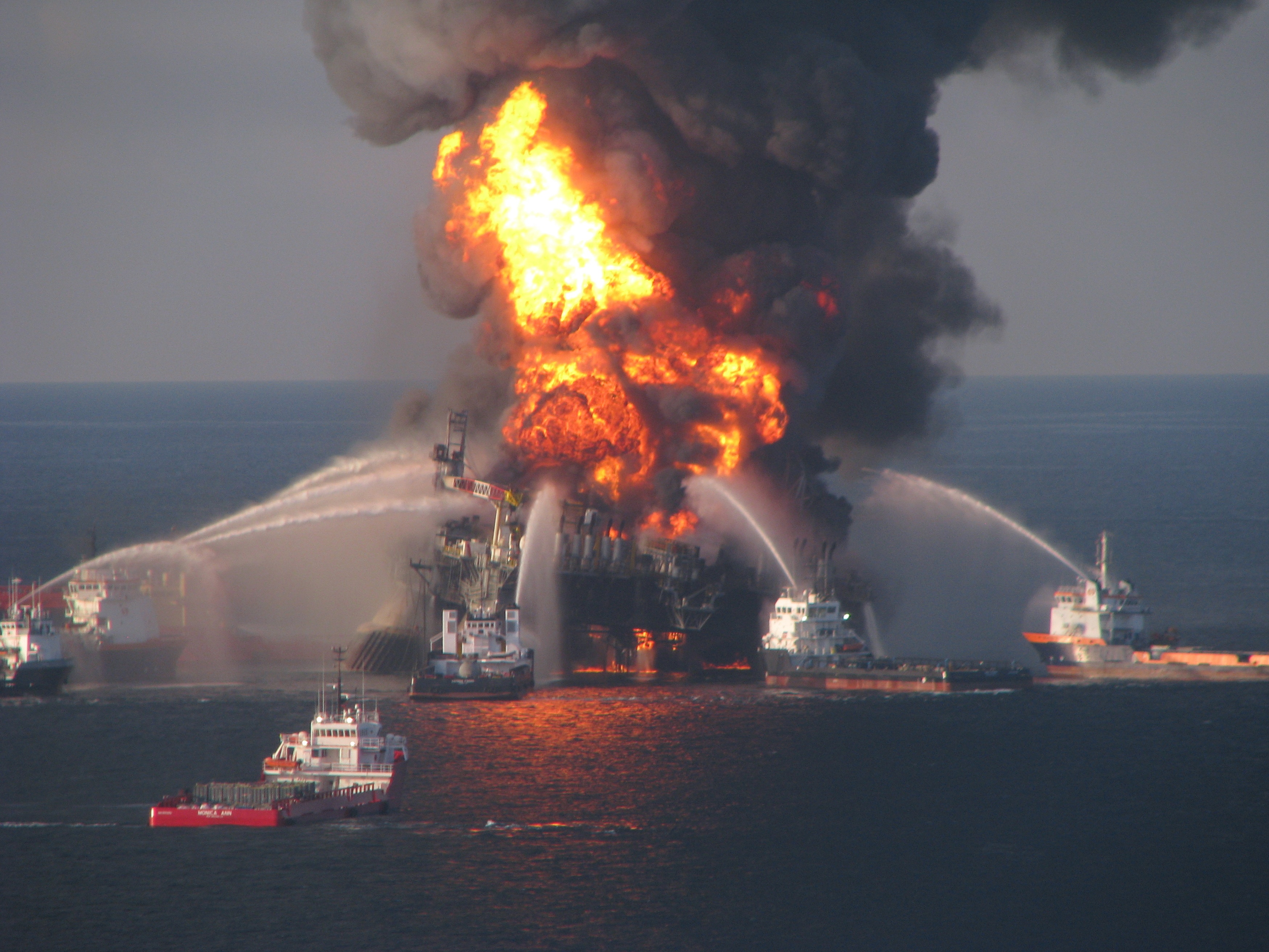
Read more about the incident here and do not forget the people who lost their lives in this terrible tragedy.
Environmental Protection Agency - EPA
Safest Catch meets Deadliest Catch.
Fishermen pursing safety at sea and sustainble fisheries.
F/V Asst. Engineers April 17, 2015
SafestCatch.Net ~ Safest Catch dot Net
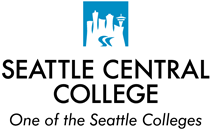
Fishing Industry Stakeholders,
I am pleased to report that Seattle Maritime Academy will soon offer a new course, Assistant Engineer, Uninspected Fishing Industry Vessels, at its Ballard campus. Working with the fishing industry and the US Coast Guard, Seattle Maritime Academy developed this unique course designed to meet the engineering licensing requirements of the Pacific Northwest commercial fishing fleet. SMA will offer this comprehensive 160 contact hour course, designed to build the requisite knowledge required by 46 CFR §11.590, beginning in June 2015. The course will be delivered in a format consisting of three modules, allowing mariners to complete it while meeting their employment commitments. The cost of the course is $2400. The Port of Seattle will fund a limited number of need-based scholarships to partially offset the cost of tuition.
The US Coast Guard will begin enforcement of license requirements for Assistant Engineers of Uninspected Fishing Industry Vessels commencing October 2015. Licensing requirements include a minimum of three years’ experience in the engine room of vessels and the passing of a US Coast Guard exam. In lieu of the exam, mariners may complete a Coast Guard approved course that covers the requisite subjects of 46 CFR §11.590.
SMA’s course will be comprised of three modules. Each module is about 55 hours of instruction. SMA will offer the three modules back-to-back starting with Module 3. Students may start with any module but must complete all three within one year. Initial dates are as listed below. Additional offerings through the end of 2016 will be published on the college’s website http://seattlecentral.edu/maritime/index.php. Industry input to course schedules is welcome.
|
Module (Classes M-F for two weeks) |
Start Dates |
||
|
Module 3 Safety, Emergency Equipment and Lifesaving Devices |
June 8 2015 |
July 20 2015 |
Aug 31 2015 |
|
Module 1 General, Electrical and Refrigeration Systems |
June 22 2015 |
Aug 3 2015 |
Sep 14 2015 |
|
Module 2 Marine Diesel Engines and Auxiliary Boilers |
July 6 2015 |
Aug 17 2015 |
Sep 28 2015 |
Seattle Maritime Academy (SMA), part of Seattle Central College, has trained mariners at its Ballard Campus for over forty-two years. SMA’s US Coast Guard approved Marine Engineering Technology and Marine Deck Technology programs provide a unique blend of focused classroom education, practical hands-on laboratory exercises, at-sea training and industry internships to prepare men and women for successful careers in the regional maritime industry.
To obtain a course schedule, learn more about the course, or register for the course, please contact Seattle Maritime Academy at (206) 934-2647 or email at This email address is being protected from spambots. You need JavaScript enabled to view it..
Best regards,
Matthew S. Von Ruden
CAPT, USCG (ret.)
Director, Seattle Maritime Academy
Seattle Central College
Office: (206) 934-2647
Direct: (206) 934-2905
This email address is being protected from spambots. You need JavaScript enabled to view it.
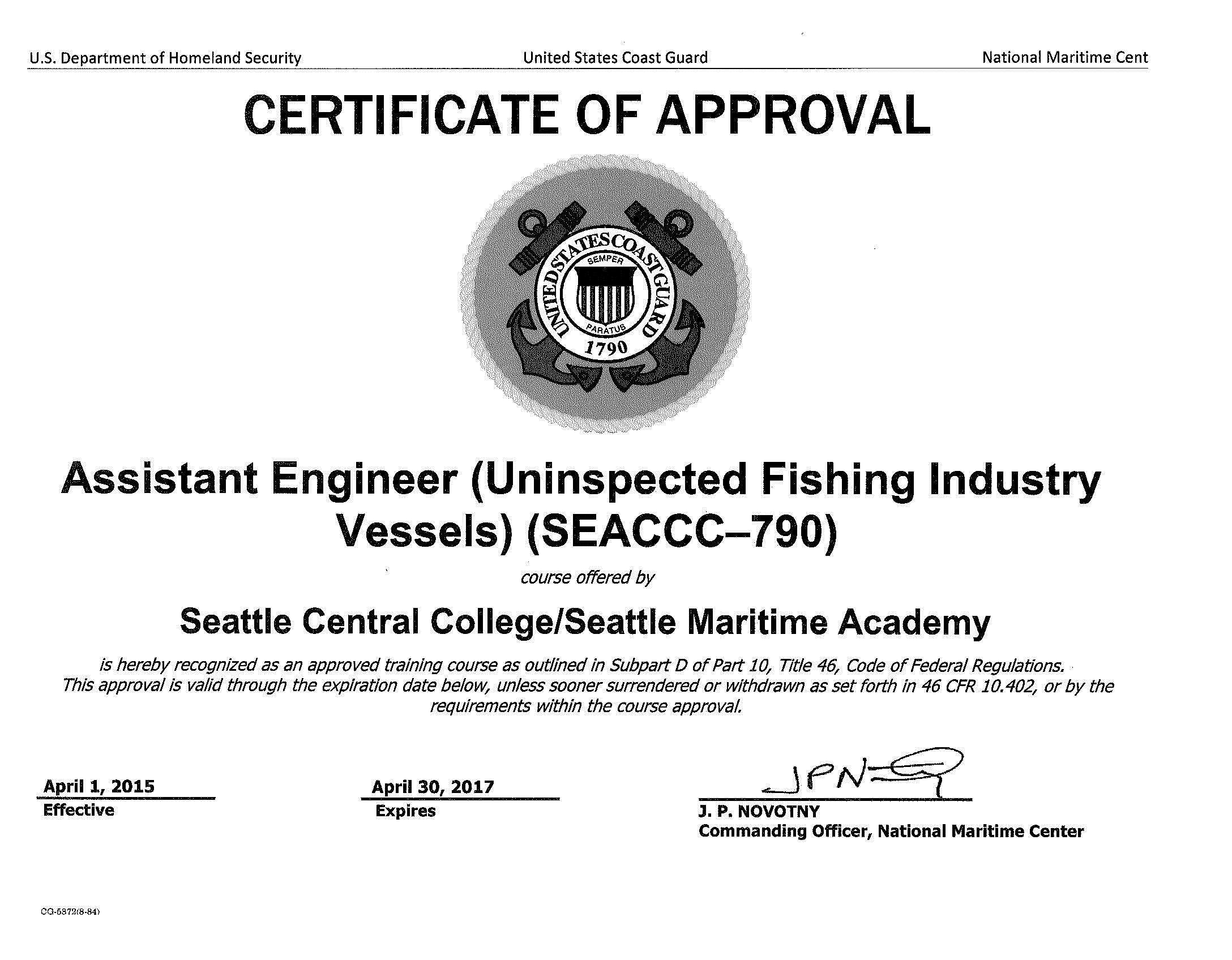

Safest Catch meets Deadlies Catch
Real Fishermen pursuing Safety at Sea and Sustainable Fisheries
Dalny Vostok Tragedy ~ April 2, 2015
SafestCatch.net ~ Safest Catch Dot Net
The goal of this website is to NOT have posts like this. I strive to find positive, safety/sustainability minded news to post about, but unfortunately, tragedies such as the sinking of the DALNY VOSTOK in the Sea of Okhotsk Thursday April 2nd continue to haunt the fishing industry world-wide.
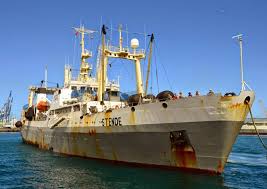
MOSCOW (AP) — Russia vowed Thursday to continue searching a vast area of the frigid Sea of Okhotsk for 13 people missing after a fishing trawler sank, killing at least 56 of the 132 people onboard.
Another 63 were found alive in the icy waters off the Kamchatka Peninsula in Russia's Far East, but the likelihood of finding other survivors appeared tiny, given the harsh conditions.
Russia's Investigative Committee has begun a probe into possible charges over safety violations in the early Thursday sinking of the Dalny Vostok, which went down in only about 15 minutes.
The emergencies ministry said the area being searched spanned about 8,800 square kilometers (3,500 square miles).
Rescued crew members reported that the ship was unstable because of empty fuel tanks and a lack of ballast, and tipped over when a fishing net weighing 80 tons was pulled in, said Oleg Kozhemyako, acting governor of the nearby Sakhalin region.
Kozhemyako's comments on Russian television came after the federal Investigative Committee said it was considering all possible causes of the sinking, including the 100-meter (330-foot) trawler hitting an object floating in the sea, possibly drifting ice.
Those saved had managed to get into lifeboats and some had put on wet suits, rescue workers said.
The Dalny Vostok sank at about 4 a.m. local time (1800 GMT Wednesday; 1 p.m. EDT Wednesday). It didn't send a distress signal.
Video of the rescue operation broadcast on state television showed clear skies and relatively calm seas. The water temperature was near freezing.
Among the people on board, 78 were from Russia, 42 from Myanmar and the rest were from Latvia, Ukraine and Vanuatu.
Pyotr Osichansky, president of the Far Eastern Association of Sea Captains, told Russian television that when the trawler last docked in Russia, in January, it had fewer than 70 crew members. The additional crew members were most likely picked up in Pusan, South Korea, and were working illegally, he said.
The Dalny Vostok, which was built in 1989, was equipped to freeze and can fish.
About 26 fishing boats and 1,300 fishermen and emergency workers were taking part in the rescue operation, scouring the water for survivors and bodies even after darkness fell, said Emergency Situations Minister Vladimir Puchkov.
The fishing boats have recovered 56 bodies so far. The Interfax news agency quoted a local emergency services representative as saying two of the bodies were found Thursday evening — one in a lifeboat 105 kilometers (65 miles) away and the other in the waters nearby.
A Mi-8 helicopter with rescue workers and doctors was deployed to deliver medical help and transport crew members to hospitals in the city of Magadan. The Emergencies Ministry also set up a telephone hotline for families of the crew.
Safest Catch dot Net - Safest meets Deadliest Catch - where real fishermen pursue safe, seaworthy, and sustainable fisheries.
OSHA Blue Book ~ March 24, 2015
SafestCatch.net ~ Safest Catch Dot Net
OSHA (Occupational Safety Health Administration) has published the long awaited Shipyard Industry Standards book.
When it comes to OSHA and the Fishing Industry in the Pacific Northwest, we see Amy Duz at IworkWise.com as the expert in coordinating the rules with the real world issues we face aboard fishing vessels.
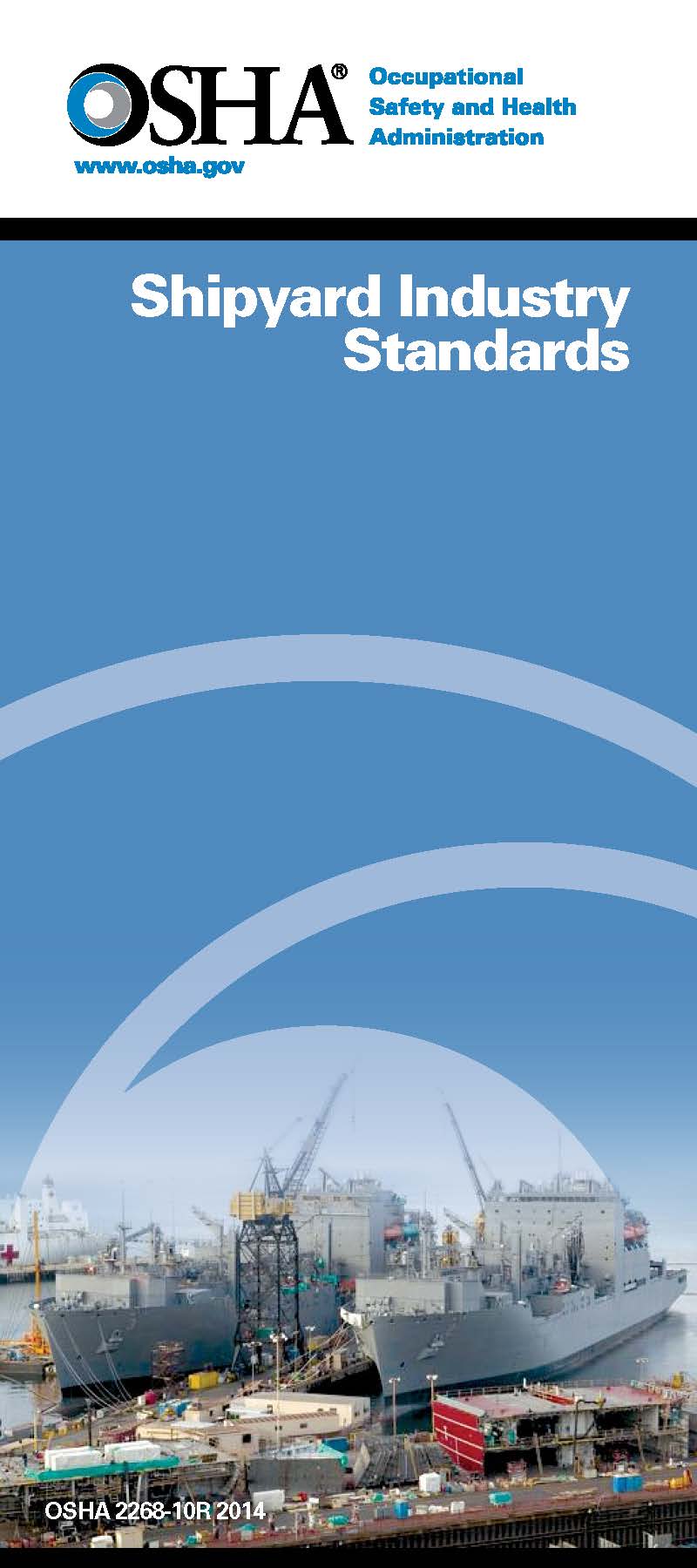
The former version of this book was Brown - commonly referred to as the Brown Shipyard Book. Well, not to confuse matters, the new one is Blue - I would expect it to be called the Blue book (shocking), moving forward.
It's a valuable piece fo safety equipment and one that I encourage all who are involved with vessels, fishing and otherwise, to take a look at. For those of us in fishing, we have the added layers of safety provided by the rules and regulations of:
- United States Coast Guard
- NIOSH Fishing
- OSHA Blue Book
- Classification Agencies (ABS, DNV, Veritas, Lloyds, etc.)
This is serious business and we appreciate the efforts of all involved to keep our work place as safe (and seaworthy) as possible.
Safest Catch dot Net - a play on Deadliest Catch - where real fishermen pursue safe, seaworthy, and sustainable fisheries.
Seafood Expo NA ~ March 15-17, 2015
SafestCatch.net ~ Safest Catch Dot Net
The Largest Seafood Trade Event in North America
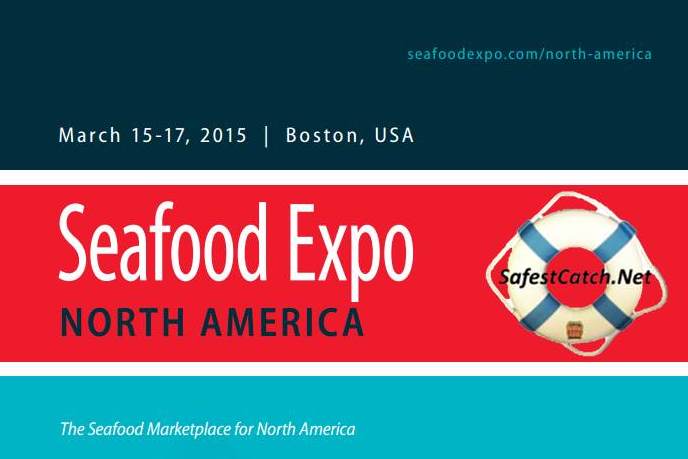
Formerly known as the International Boston Seafood Show/Seafood Processing America, Seafood Expo North America/Seafood Processing North America is the largest seafood trade event in North America. The event attracts over 20,000 buyers and suppliers of fresh, frozen, packaged and value-added seafood products, equipment, and services. Attendees travel from more than 100 countries to do business at the exposition.
Read more:
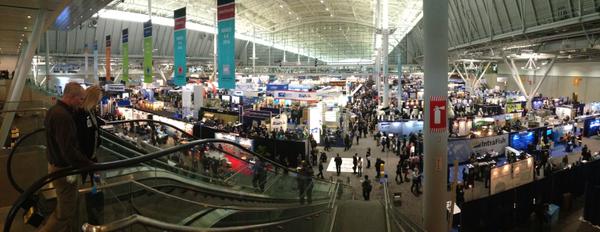
SafestCatch.Net ~ Safest Catch dot Net
Deadliest Catch meets Safest Catch ~ real fishermen pursuing safety and sustainability.
F/V Alaska Ranger Sinking - March 10, 2015
SafestCatch.net ~ Safest Catch Dot Net
March 23 marks the 7th Anniversary of the Alaska Ranger sinking - March 23, 2008.
I was with my parents and family on the 22nd (Easter Sunday) as we heard the news of the tragedy and were glued to our phones and internet throughout the day as we had another member of our family working for Fishing Company of Alaska (owner of the Alaska Ranger). I was in Captain's Nautical Supply today and saw the book on the stand and a flood of emotion and memories came over me. Although its a sad story, in my mind much of the pain caused by this sinking was avoidable. Read the book below and see the additional information from Wikipedia and make your own decision.
Buy the book here: Amazon
FV Alaska Ranger was a fishing factory ship owned and operated by the Fishing Company of Alaska of Seattle, Washington. The ship was constructed in 1973 for use as an oil field service vessel. The ship sank 23 March 2008, after reporting progressive flooding only hours earlier. Of the 47 on board, 42 were rescued. Of the five fatalities, four were recovered dead, and one was never found. The Coast Guard was initially misinformed about the number of persons on board the vessel, and secured the search with one crew member still unaccounted for. After realizing there was still one person missing, the Coast Guard reinstated the search, but did not find the crew member.
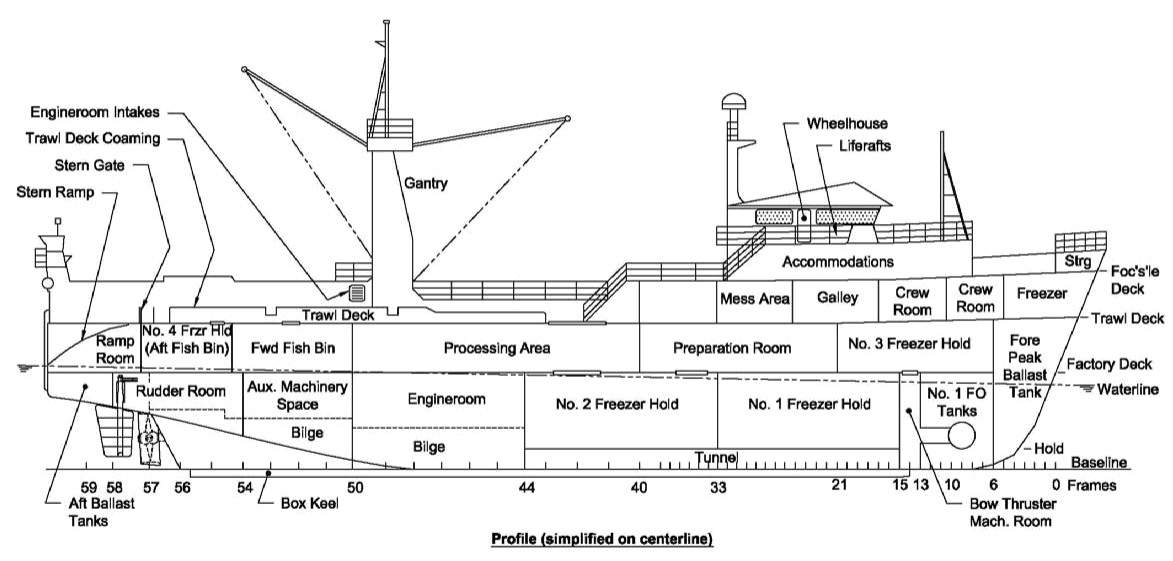
According to the United States NTSB (National Transportation Safety Board), the triggering event in the sinking was the loss of one of the two rudders. This allowed water to pour into the rudder room by way of the 9-inch diameter rudder trunk. The marine architect designed the opening of the rudder trunks to be above the waterline so that water would not enter the rudder room should a rudder fall out. However, United Marine Shipbuilding changed the ship from an oil well service boat to a fishing boat in 1988. The changes raised the waterline 2.5 feet. This put the rudder trunk openings below the water line. The ceiling of the rudder room was only 20 inches above the trunk openings. Flooding of the rudder room should not have sunk the ship since there was a watertight bulkhead. The NTSB can only speculate that the door was left open, the seals or latching dogs failed, or that the holes cut in the bulkhead for refrigeration lines needed for fish processing were not watertight. If the conversion installed a watertight bulkhead between sections of the fish processing area the boat would not have sunk. Whatever the reason, the water flooded the engine room. At some point the water level became high enough to short out the main electrical distribution panel. This caused the loss of electrical power throughout the boat.
The boat had variable-pitch propellers. This means the captain can keep the diesel engines at a constant RPM needed for the ac electrical generators, and use the variable pitch to change boat speed or reverse direction. The variable-pitch propellers used a hydraulic actuation system. As designed, there was one electrical hydraulic pump and one engine-driven mechanical hydraulic pump for each propeller. In 1989, Transmarine Propulsion Systems replaced both mechanical pumps with electric pumps, saying they could not get parts for the mechanical pumps.
With electrical power lost, all 4 hydraulic pumps stopped. With no hydraulic pressure, hydrodynamic forces on the propellers caused the pitch to reverse. This made the boat run full astern. The rearward motion of the boat drove the sinking aft section further under water. It also exacerbated water entry into the air intake vents on the trawl deck.
The Captain died in the sinking so it is unknown why he did not stop the diesel engines. The Coast Guard had tested the engine emergency shutoff system a year before the sinking and reported that it functioned properly. The boat moving full astern meant that two of the three lifeboats were separated from the ship. This meant that 25 crew members that had jumped into the water never got to one of the three lifeboats.
United States Coast Guard Marine Board of Investigation
The United States Coast Guard also investigated the sinking through a Marine Board of Investigation. The Marine Board's Report of Investigation determined a different scenario related to the cause of the casualty. The Marine Board reviewed thousands of pages of documents and photographs related to the maintenance and repair of the vessel, and examined in-depth the installation of the Kort nozzles. The Marine Board also examined in detail the rudder installation.
As a result of this analysis the report concludes that "Though the exact initiating event that created the source of flooding is unknown, it was likely related to the poor material condition of the vessel and may have been related to the Kort nozzle struts which are believed to have experienced excessive stresses where they were attached to the hull."
Crew rescue
The unexpected and unexplained flooding of the ship meant that the crew had to abandon the vessel at night, into the frigid waters of the Bering Sea. Radio pleas for help were forwarded to a US Coast Guard vessel, which moved toward the area while dispatching helicopters. By the end of the effort, 42 of the 47-person crew had been located and brought safely to shore, most suffering severe hypothermia.
The rescue was carried out by a USCG HH-60 Jayhawk which was stationed on Saint Paul Island, AK and a HH-65 Dolphin which was attached to the USCGC Munro, which rescued 20 people, and 22 were rescued by Alaska Ranger’s sister ship FV Alaska Warrior.[3] The ship sank 180 miles west of Dutch Harbor.[4]
Aviation Week & Space Technology magazine awarded its 2009 Aviation Week Heroism Award to the U.S. Coast Guard Rescue Team involved in this rescue operation, stating: "The two helicopter crews displayed exceptional risk mitigation and airmanship in fighting time, distance and weather – including snow squalls, a −24°F wind chill, 15 ft seas and 30 kt winds – to rescue survivors. The USCG deems the operation the largest cold-water rescue in its history."[5]
The story of the sinking and subsequent rescue was published in 2010 as Deadliest Sea: The Untold Story Behind the Greatest Rescue in Coast Guard History by Kalee Thompson.[6]
A brief version of the Alaska Ranger story was told at the conclusion of the Deadliest Catch season 4 finale.
A Discovery Channel program Mayday! Bering Sea covers the accident and rescue.
OURS IS NOT AN ORDINARY BUSINESS - That's why, more than ever, Professional, Safety Conscious At Sea operations are MANDATORY.
SafestCatch.Net ~ Safest Catch dot Net
Deadliest Catch meets Safest Catch ~ real fishermen pursuing safety and sustainability.
Wakefield & Deep Sea 2/22/2015
SafestCatch.Net ~ Safest Catch dot Net
Wakefield Foods and the vessel Deep Sea both played a part in getting me to the place I am today. When my father was working with partners to build the Rainier at Martinolich Shipbuilding in Tacoma in the early 1970's Seattle First National Bank was a little less than willing to loan them money to build the boat. The story goes that Wakefiled, their market (company who was committing to buying the crab produced by the Rainier), told the bank, either loan them the money or we move our money. The rest is history.
Then, later in the progression of the family business, the Deep Sea was purchased, again with partners and was anchored in Akutan Bay (3 hour steam from Unalaska port of Dutch Harbor), where it processed Alaska King Crab & Tanner (Bairdi and Opilio) Crab in the mid to late 1970's. The vessel unfortunately later was derelict and sank off of Whidbey Island. Read more about the sad ending to the life of the first true Alaksa Crab Vessel here: Penn Cove Mussel Harvest Suspended After Boat Fire, Sinking
Read about the Deep Sea in the biography of Konrad Uri NW Fisheries Association Person of the Year
Without Wakefield Foods and the vessel Deep Sea, there would be no Rainer, Pengwin, Isafjord, Pavlof, Arctic Trawler, Trans Pac, Roughneck. And then of course the vessels before - Kristine and Seaview and associated vessels after - US Liberator, US Intrepid, and American No.1
SafestCatch.net ~ Safest Catch dot Net
Real Fishermen pursuing safe and sustainable fishing practices.
Happy Lunar New Year 2/19/2015
SafestCatch.Net ~ Safest Catch dot Net
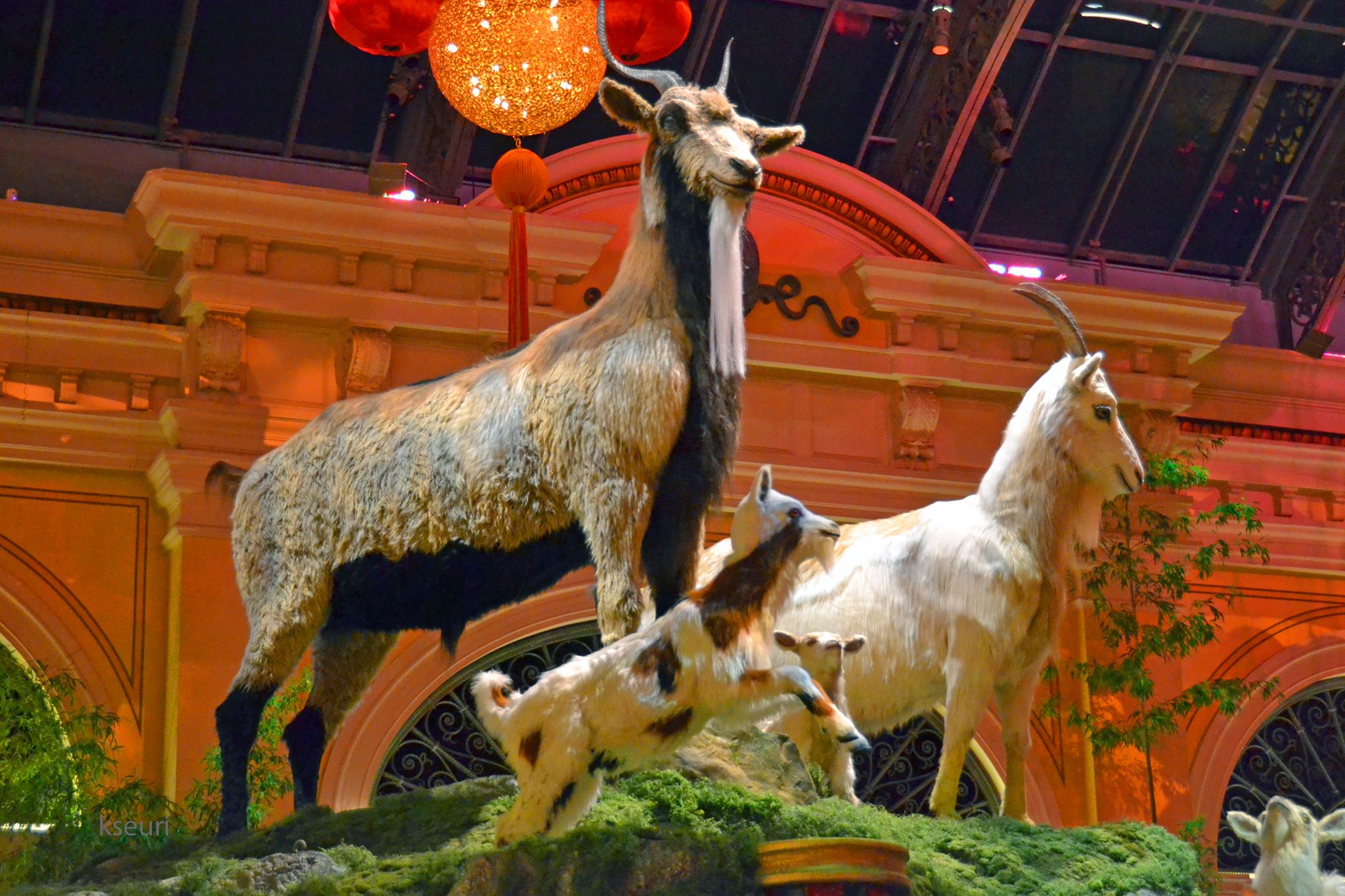
The Chinese commonly regard sheep as an auspicious animal, and the Year of the Sheep, therefore, heralds a year of promise and prosperity.
Individuals born in this zodiac year share certain characteristics with other individuals also born in years of the same animal sign. Similarly, years sharing the same animal sign share certain characteristics, repeating over their 12/60 year cycle.
Due to the luni-solar nature of the traditional Chinese calendar system, the "zodiacal" year does not align with the Western calendar: new years are determined by a system which results in each new year beginning on a new moon sometime between late January to mid-to-late February. Goat aspects can also enter by other chronomantic factors or measures, such as hourly.
In Chinese astrology Goats are described as loving-peace and "kind" and "popular". With the addition of the wood element, the Goat characteristic is thought to love peace and to be helpful and trusting, but yet also to be "clinging" and of a nature resistant to change.

SafestCatch.net ~ Safest Catch dot Net
Real Fishermen pursuing safe and sustainable fishing practices.
Animal Planet 2/14/2015
SafestCatch.Net ~ Safest Catch dot Net
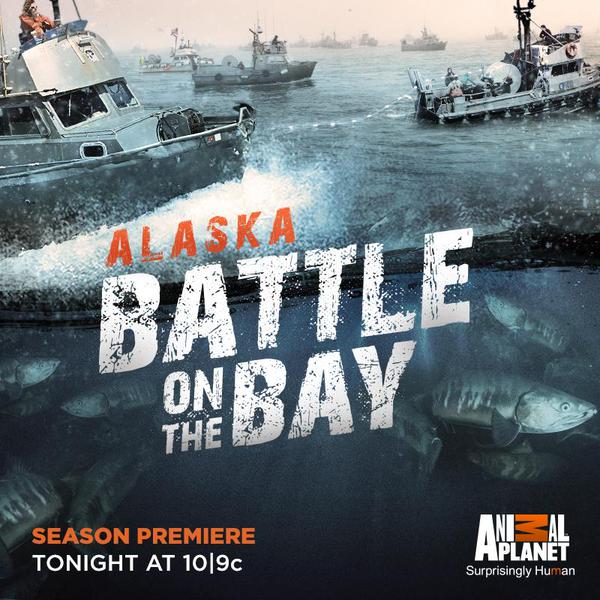
First Deadliest Catch, now Battle on the Bay?
Read the concerns of the Bristol Bay Regional Seafood Development Association - click link below:
Truths and clarifications about Alaska’s Bristol Bay salmon fishery
Specifically, read Sue Aspelund's (BBRDA Executive Director) letter to Discovery Channel/TLC/Animal Planet.
Note her concerns of inaccurate:
- fisheries quota representations
- environmental harm accusations
- vessel ramming deaths
- fishing mainly 'the line'
- lack of concern for quality
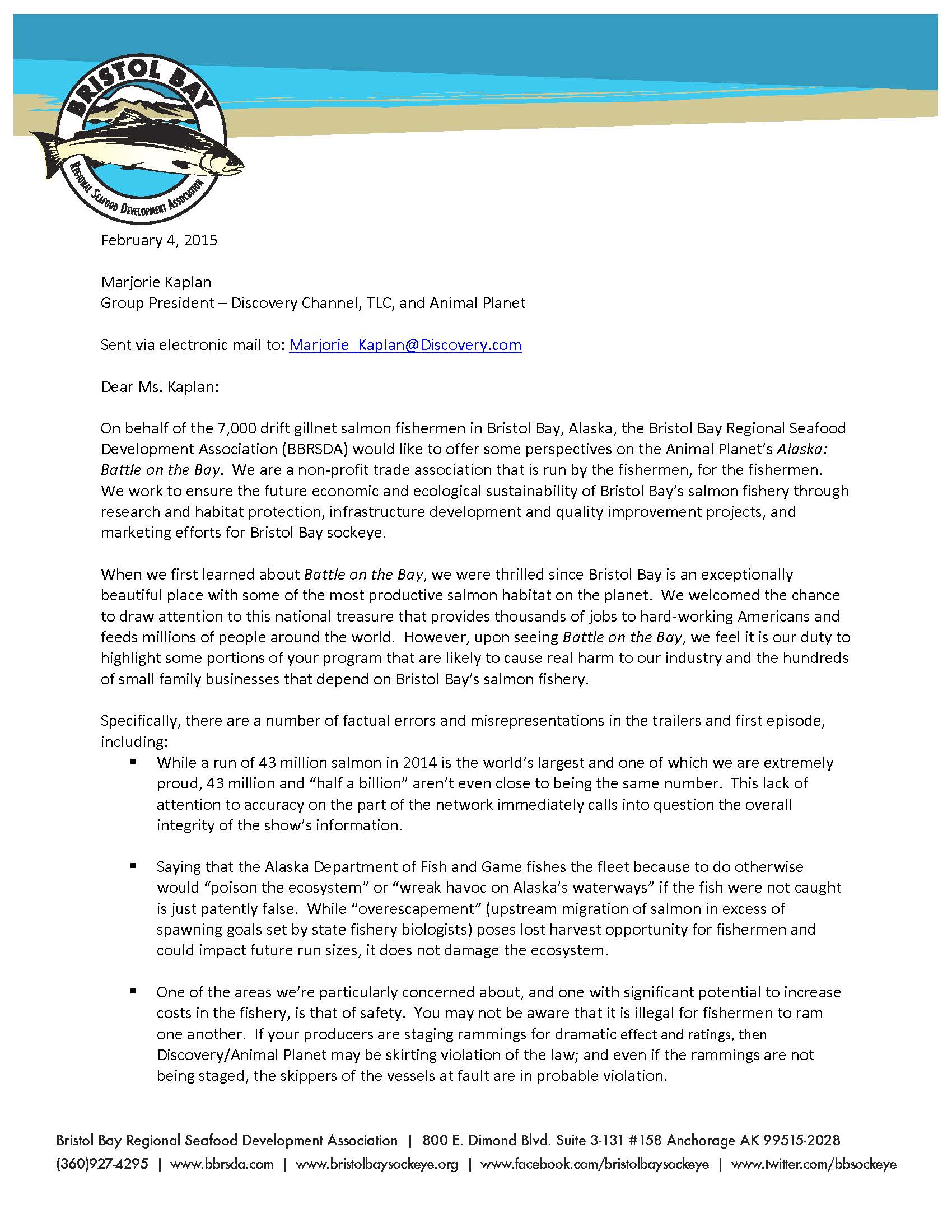
February 4, 2015 letter from Sue Aspelund, BBRDA to Discovery Channel, TLC, Animal Planet
Page 2

Deadliest Catch meets Safest Catch ~ real fishermen pursuing safety and sustainability.
SafestCatch.Net ~ Safest Catch dot Net
Bering Sea Hilborn 2/5/2015
SafestCatch.Net ~ Safest Catch dot Net
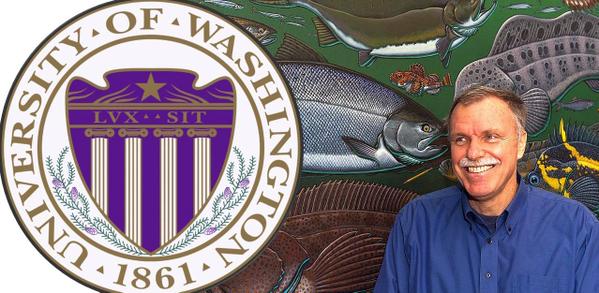
Bering Sea health: Fishing is not a threat
Posted by Letters Coordinator
In their guest column “Saving ocean habitat before it’s drained, Opinion, Feb. 1,” the authors suggest that protecting the Bering Sea canyons would help “save the oceans.” While it is true that the oceans are threatened in many ways, the Bering Sea is not threatened by fishing. It is in fact one of the best-managed fisheries in the world, with annual harvests well below scientific advice on what is sustainable.
National Oceanic and Atmospheric Administration research has shown there is nothing unique about the flora and fauna of these canyons, and they are not heavily fished. Only about 30 percent of the Bering Sea is impacted by bottom trawling, and the seafloor of the Bering Sea is relatively resilient to trawling.
The real threats are from ocean acidification, global warming, pollution, land-based runoff and unregulated fishing. Closing sections of the Bering Sea to fishing would have no impact on any of these. If the authors must focus on fishing, then they should look to the places in the world where fisheries are poorly regulated.
Ray Hilborn, UW professor School of Aquatic and Fishery Sciences
Deadliest Catch meets Safest Catch ~ real fishermen pursuing safety and sustainability.
AK Fishing OSHA 1/27/2015
SafestCatch.Net ~ Safest Catch dot Net
The information below was kindly provided by our industry OSHA expert, former safety manager at Icicle Seafoods, Amy Duz. Visit her I Work Wise website and partake in her classes - she is an invaluable asset to our Industry and has made an indelible mark on improving Safety in the Fishing Industry of the North Pacific and Bering Sea. For those who operate out of Dutch Harbor, February tends to be a month of OSHA (Occupational Safety & Health Administration - Federal) spot inspections - the list below will help you prepare.
I can't stress this enough - the key to a safe work place is to just get your crew to start THINKING SAFETY.
Something as simple as requiring your crew to wear hard hats and safety glasses and then having the boss lead by example can make the difference between life and death. THINK - Safety is no Accident.
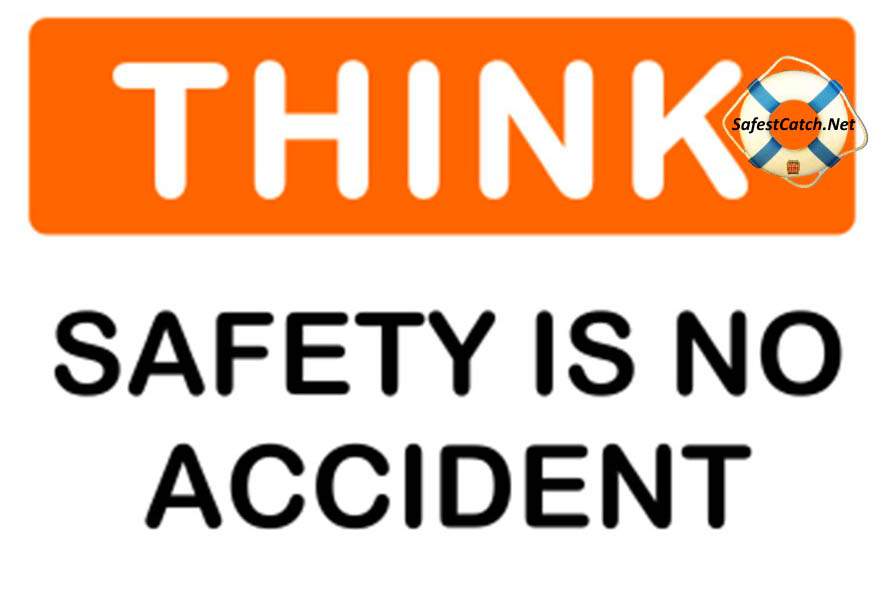
Most Frequently Cited Violations, Alaska Fishing Industry (vessels) October 2013 thru Sept 2014
|
Standard |
Citations |
Inspections |
Penalty |
Description |
|
111 |
42 |
$292,874 |
All Standards cited |
|
|
14 |
7 |
$52,330 |
Lockout/tagout. |
|
|
10 |
9 |
$18,865 |
Hazard Communication. |
|
|
8 |
5 |
$10,500 |
Forklifts. |
|
|
7 |
6 |
$32,180 |
Machine guarding. |
|
|
7 |
3 |
$29,345 |
Electrical, wiring, electrical equipment, cords. |
|
|
6 |
5 |
$7,246 |
Lockout/Tags-plus. |
|
|
6 |
6 |
$53,299 |
OSH Act General Duty 5(a)(1). |
|
|
5 |
5 |
$13,410 |
Eyewash stations. |
|
|
3 |
2 |
$216 |
Annual summary, OSHA Form 300A not posted, or not complete. |
|
|
3 |
1 |
$5,390 |
Respiratory Protection. |
|
|
2 |
1 |
$2,250 |
Guarding floor openings and holes. |
|
|
2 |
2 |
$3,600 |
Fixed ladders. |
|
|
2 |
2 |
$6,640 |
PPE. |
|
|
2 |
2 |
$2,381 |
Sanitation. |
|
|
2 |
2 |
$4,700 |
Shaft, pulley, belt guarding. |
|
|
2 |
2 |
$3,850 |
Electrical. |
|
|
2 |
1 |
$0 |
Air contaminants. |
|
|
2 |
2 |
$2,844 |
PPE Hard hats, gloves, safety glasses, goggles, face shields, etc. |
|
|
1 |
1 |
$0 |
OSH Forms. |
|
|
1 |
1 |
$700 |
OSHA Forms. |
|
|
1 |
1 |
$1,260 |
OSHA fatality/injury reporting. |
|
|
1 |
1 |
$0 |
OSHA Forms not available. |
|
|
1 |
1 |
$1,785 |
Housekeeping. |
|
|
1 |
1 |
$5,390 |
Design and construction requirements for exit routes. |
|
|
1 |
1 |
$0 |
Occupational noise exposure. |
|
|
1 |
1 |
$0 |
Compressed gases (general requirements). |
|
|
1 |
1 |
$5,390 |
HAZWOPER. |
|
|
1 |
1 |
$0 |
Abrasive wheel machinery/grinders. |
|
|
1 |
1 |
$0 |
Hand and portable powered tools and equipment, general. |
|
|
1 |
1 |
$3,850 |
Electrical PPE. |
|
|
1 |
1 |
$1,764 |
Confined and enclosed spaces. |
|
|
1 |
1 |
$0 |
Hot Work. |
|
|
1 |
1 |
$1,626 |
Guarding of deck openings and edges. |
|
|
1 |
1 |
$2,550 |
Chain falls and pull-lifts. |
|
|
1 |
1 |
$648 |
Abrasive wheels/grinders. |
|
|
1 |
1 |
$0 |
Fall arrest equipment/training. |
|
|
1 |
1 |
$8,400 |
Hot work precautions. |
|
|
1 |
1 |
$0 |
Fire watch. |
|
|
1 |
1 |
$0 |
First aid and lifesaving facilities (shoreside, offload). |
|
|
1 |
1 |
$1,900 |
Powered industrial trucks (shoreside, offload). |
|
|
1 |
1 |
$1,900 |
Guarding of edges (shoreside, offload). |
|
|
1 |
1 |
$1,296 |
Cranes and cargo gear certification. |
|
|
1 |
1 |
$3,750 |
Gangways. |
|
|
1 |
1 |
$1,620 |
Powered conveyors. |
Lockout/Tag-plus Log Retention
This email regarding retention of lockout/tags-plus logs in from Scott Ketcham, OSHA Area Director – Alaska.
“Below is the policy I was informed to enforce from our National Office.
Employers need to retain all LOTO records and a continuous log of these records until the next 1915.89(q) program audit.
After completion of the program audit required by 1915.89(q) the employer may discard the LOTO records.”
NOTE: OSHA does not require this in the regulation, nor have they issues any official interpretations on this.
Postings
Post the OSHA 300A Form from February 1st through April 30 in an accessible location for employees to see.
OSHA Reporting Changes effective 1/1/2015:
You must report the following incidents occurring within 3 miles within the indicated timeframes to OSHA:
· A work related fatality or any fatal heart attack within 8 hrs
· Any work-related hospitalization, amputation, loss of an eye, or any non-fatal heart attack within 24 hrs
Amy Duz
iWorkWise
Phone: 206-310-5512
From my experience, OSHA tends to inspect vessels in Unalaska port of Dutch Harbor, Alaska during the month of February. This may or may not be the same in other Alaska ports (i.e., Adak, Atka, Sand Point, St. Paul, St. George, False Pass, Kodiak, Seward, Yakutat, Ketchikan, etc.)
Deadliest Catch meets Safest Catch ~ real fishermen pursuing safety and sustainability.
Flatfish Bycatch 1/24/2015
SafestCatch.Net ~ Safest Catch dot Net
The multi species groundfish trawlers of the North Pacific and Bering Sea are among the most innovative and successful in science/industry collaboration to reduce environmental impact and increase production of the 'perfect' protein - Wild, worthy of Organic, Fish from the waters off Alaska.
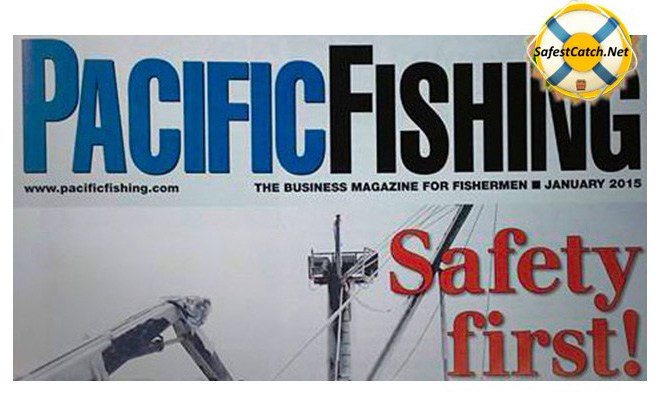
In a commentary released online yesterday by Pacific Fishing Magazine, Groundfish Forum Executive Director, and former United States Coast Guard Commander, Chris Woodley weighs in on the Importance of the flatfish trawl fishery and their committment to halibut bycatch reduction:
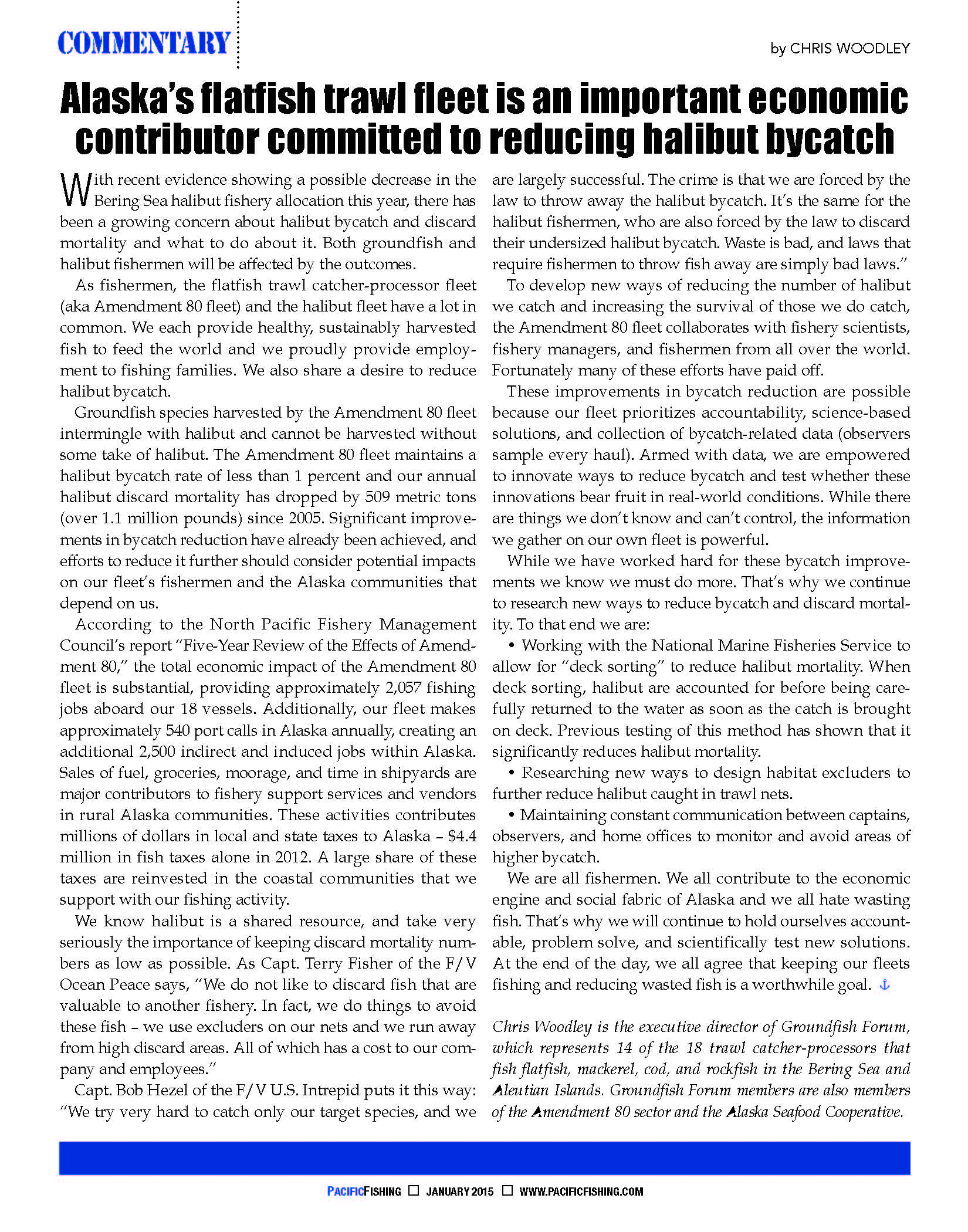
SafestCatch.net ~ Safest Catch dot Net
Real Fishermen pursuing safe and sustainable fishing practices.
Bristol Bay Oil 12/20/2014
SafestCatch.Net ~ Safest Catch dot Net
While I'd like to take some credit for President Obama's action earlier this week to protect Bristol Bay from Oil and Gas exploration (perhaps he was watching our Facebook/SafestCatch postings?), I am just THANKFUL that he had the vision to protect the 'richest fish stocks in the world.' Read the White House Press Release.
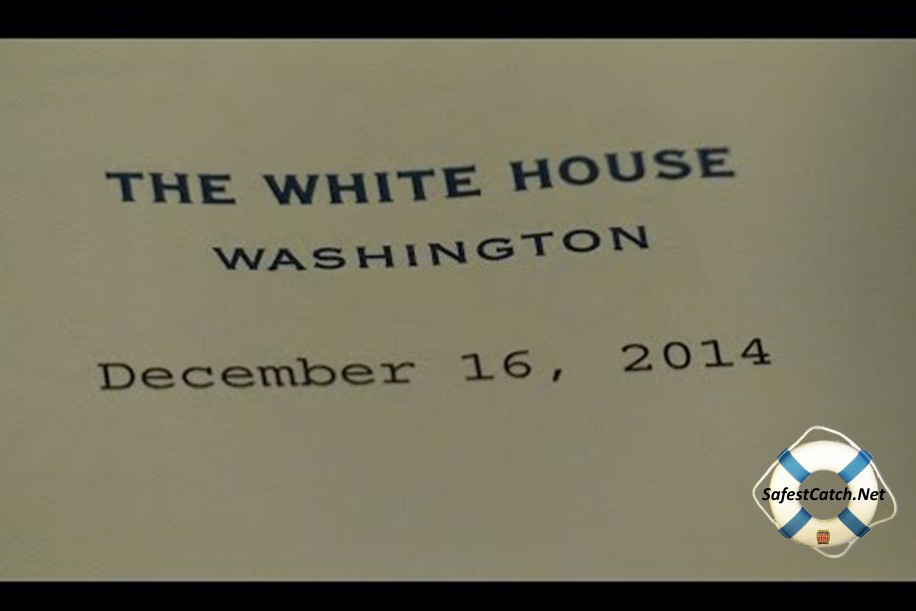
Politics can be tricky and I know there will be those out there who criticize the timing of the announcement (after Congress was on Christmas recess), but I am just taking it for what it is - protection for the waters that support my industry.
Read more:
Now, let's get this job done and STOP the Pebble Mine
Deadliest Catch meets Safest Catch ~ real fishermen pursuing safety and sustainability.
Northwest Fisheries 12/13/14
Association Party
(AKA Konrad Uri's 80th Birthday)
SafestCatch.Net ~ Safest Catch dot Net
Our favorite party of the year: Northwest Fisheries Association Annual Holiday Party.
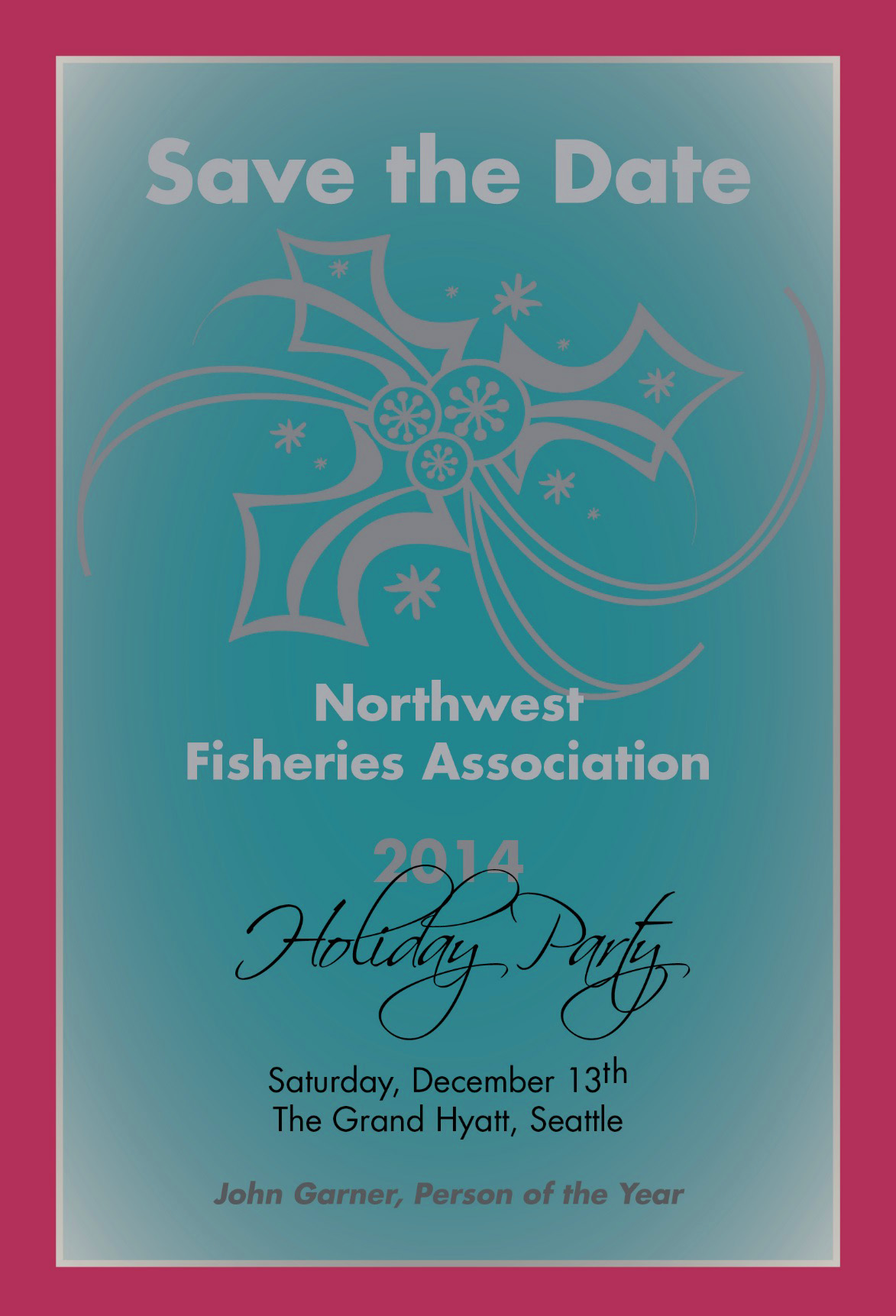
The event honored John Garner as person of the year; a previous honoree close to me is of course, my Father, Konrad S. Uri who happened to turn 80 years old and was serenaded by Everette Anderson and the entire crowd - really a fitting tribute for a lifelong fisherman who would rather be fishing at 80 years old than retired!

Pictured above are Helen, Konrad, and Beth Ann Uri. Read more about Konrad here: NWFA Person of the year 2011
Read more about the Northwest Fisheries Association, where my colleague Wayne Okino will be on the board in the coming year, here: NWFA
And here's a link to a few pictures from the evening: NWFA Picasa
SafestCatch.net ~ Safest Catch dot Net
Real Fishermen pursuing safe and sustainable fishing practices.
Think Safety 12/6/2014
SafestCatch.Net ~ Safest Catch dot Net

Why do we do safety drills? Why preach Safety?
I don't want this site to become nothing but a recap of accidents/tragedies. That is WHY I'm doing this. To get people thinking about Safety and hopefully prevent maritime accidents. It's that simple.
I am concerned with the cavalier attitude that 'Deadliest' is something to be rewarded or looked up to. When I mention that boats I'm involved with are 'Safest Catch,' (typically in response to - 'oh, I know what you do, I watch the show!') it is often as if I've hurt the person who thought they were making a connection with me through TV.
Get your mind in the Safety Mode and THINK. Just think and take a look around you and try to make a difference.
SafestCatch.net ~ Safest Catch dot Net
Real Fishermen pursuing safe and sustainable fishing practices.
Oryong 501 12/1/2014
SafestCatch.Net ~ Safest Catch dot Net
As has been reported from many news sources, the Oryong 501 (IMO: 7388504), an 85m (279') South Korean trawler sank in the Bering Sea off the coast of Russia's far Eastern Chukotka Region (580 miles Northwest of Dutch Harbor).
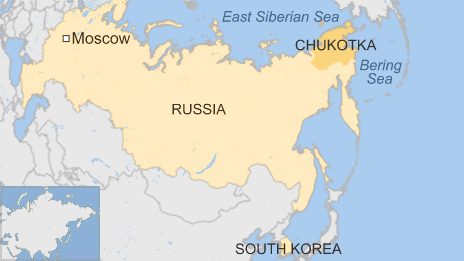
Note the Aleutian Chain in the map above is nearly perpindicular (keep in mind when looking at the Chakotka Peninsula). The vessel wend down on December 1st at 05:30 am GMT. The last AIS signal was dated November 27th at 62 17.05N x 177 47.62E in the Anadyr Bay.
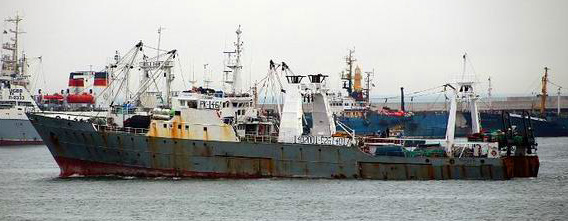
The vessel was reportedly (Fleetmon.com) hauling back a trawl and capsized when hit by a wave; thought to be due to poor/improper ballasting, causing the vessel to heel and flood.
Reportedly, 1 crewmember has died of hypothermia and 7 others have been rescued (condition unkown); 52 missing. A Coast Guard member is reported to have said, "This is the worst fishing accident I'm aware of in the Bering Sea."
Read More:
Deadliest Catch meets Safest Catch ~ real fishermen pursuing safety and sustainability.
Fish Expo 11/21/2014
SafestCatch.Net ~ Safest Catch dot Net
The Pacific Marine Expo (aka FISH EXPO!) was held this week at the Century Link Field Event Center (aka the "Clink").
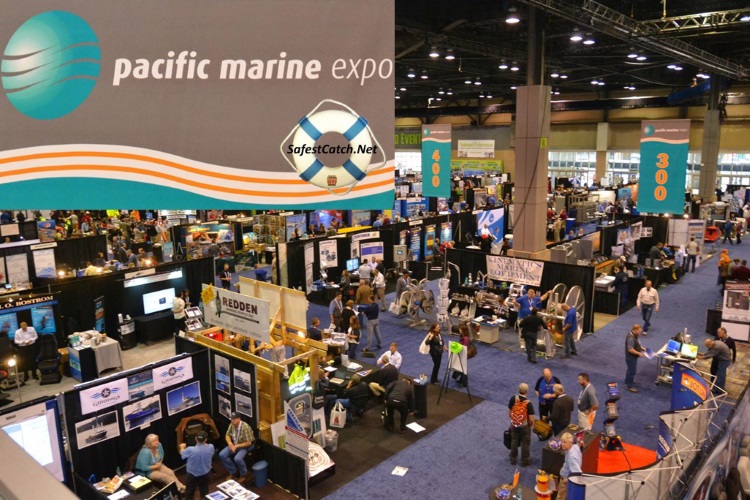
I made a quick trip through the event, focussing on Safety Equipment/Supplies/Training - it was nice to see the strong presence of Safety at the Show. For more information, please click Photos from Pacific Marine Expo.
For more information on the Show, please visit their website: www.PacificMarineExpo.com
Deadliest Catch meets Safest Catch ~ real fishermen pursuing safety and sustainability.
Fishermen's Memorial 11/18/2014
SafestCatch.Net ~ Safest Catch dot Net
The Seattle Fishing Community Gathered on Tuesday November 18th to remember those that have gone before us and raise funds at it's annual Dinner Auction. The Seattle Fishermen's Memorial provides a valuable service to the community and we were honored to attend.
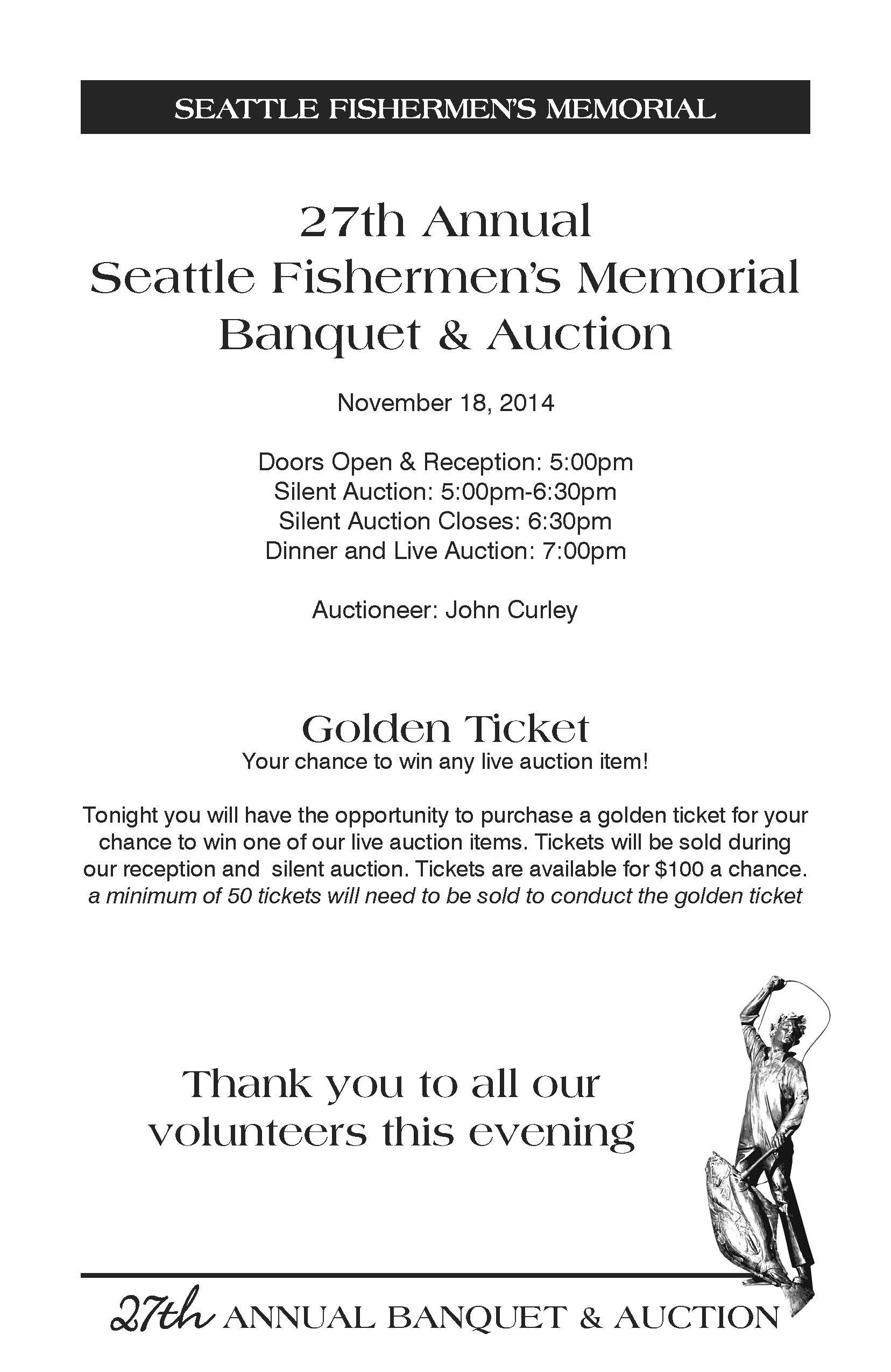
For more information on the Memorial, please visit their website: www.seattlefishermensmemorial.org
For a complete list of the program from this year's event, please see 27th Annual Dinner Auction Program
Deadliest Catch meets Safest Catch ~ real fishermen pursuing safety and sustainability.
Typhoon NURI 11/5/2014
SafestCatch.Net ~ Safest Catch dot Net
UPDATE: 11/9/2014 ~ Contrary to the dire forecast, we are happy to report that the Storm went far East of the fishing grounds (towards Russia) and the major Fishing Port of Dutch Harbor was not impacted whatsoever. We are HAPPY to report GOOD news for a change!
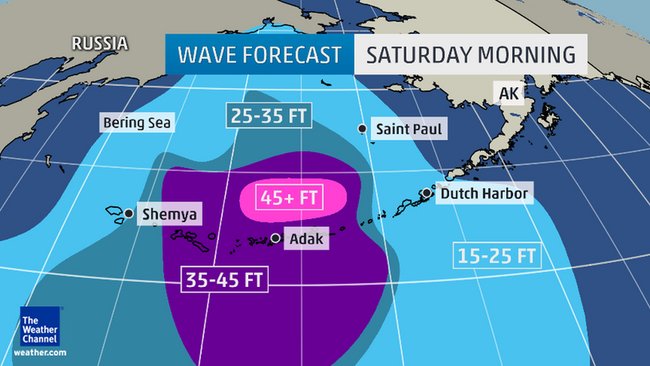
The remnant of Typhoon Nuri is expected to join up with the polar jet stream and a very strong disturbance in the mid-latitude belt of westerly winds
Forecasts from both the European (ECMWF) and American (GFS) computer models continue to predict an extremely powerful non-tropical storm to develop from this merger over the Bering Sea, near the western Aleutian Islands of Alaska Friday into Saturday.
Read more: The Weather Channel
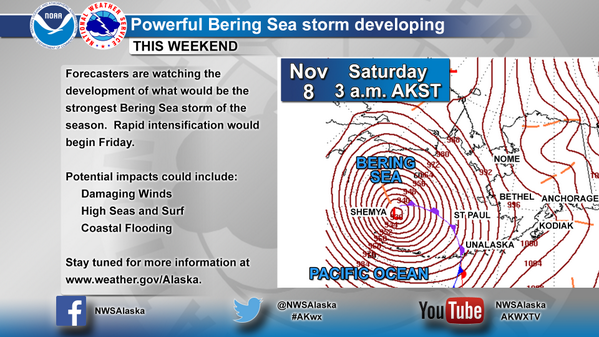
Dr. Jeff Masters posted today on Weather Underground that Typhoon Nuri is down to Category 1 strength as it steams to the northeast at 11 mph towards Alaska.
Satellite loops show that Nuri has maintained a large area of heavy thunderstorms, but the eye is no longer visible, and high wind shear of 20 - 30 knots is significantly disrupting the storm. Nuri will lose its tropical characteristics on Thursday as it becomes embedded in a cold front. As the extratropical version of Nuri moves into the Bering Sea to the west of Alaska on Friday, a very powerful jet stream will interact with the storm and cause it to rapidly intensify into one of the strongest low pressure systems ever observed in the Pacific Ocean.
Ex-Nuri's central pressure is forecast to drop from around 970 mb late Thursday night to about 918 mb late Friday night. The 00Z Wednesday run of the European model predicted that ex-Nuri would bottom out near 918 mb at 03Z Saturday, about 300 miles west-northwest of the westernmost Aleutian Island, Attu. The 00Z Wednesday GFS model had the storm reaching 918 mb 300 miles north of Attu.
The NWS in Anchorage is predicting that a large swath of hurricane force winds will be possible from Shemya eastward to Adak and Atka in the Aleutian Islands late Friday into Saturday, with seas building to 45 feet or higher. A storm surge of 2' is predicted at St. Lawrence Island on Saturday morning, and over 1' at Nome.
Read more at the National Weather Service Alaska
Deadliest Catch meets Safest Catch ~ real fishermen pursuing safety and sustainability.
NPFVOA Ebola 10/29/2014
Safest Catch dot Net ~ SafestCatch.Net

Click for full details of the presentation this week in Fishermen's Terminal / Seattle: NPFVOA Ebola & Maritime
North Pacific Fishing Vessel Owner's Association
Deadliest Catch meets Safest Catch ~ real fishermen pursuing safety and sustainability.
Pebble Mine 10/25/2014
Safest Catch dot Net ~ SafestCatch.Net

Roughly 200 miles southwest of Anchorage, Alaska, and just north of Lake Iliamna, the Pebble Limited Partnership (commonly called the Pebble Partnership of Anglo American PLC and Northern Dynasty Minerals), intends to build the Pebble mine, consisting of what would be the largest open pit mine in North America, and an additional large underground block-cave mine. Owners hope to excavate billions of tons of raw ore, primarily seeking significant quantities of copper, gold and molybdenum, along with smaller yields of silver, palladium and rhenium.
This pristine wilderness, which includes prime spawning habitat for the world's most productive wild sockeye fishery, would be devastated by the Pebble Mine.
Read more at United Tribes of Bristol Bay
Deadliest Catch meets Safest Catch ~ real fishermen pursuing safety and sustainability.
United States Coast Guard Ebola Virus Precautions - October 22, 2014
Safest Catch dot Net ~ SafestCatch.Net
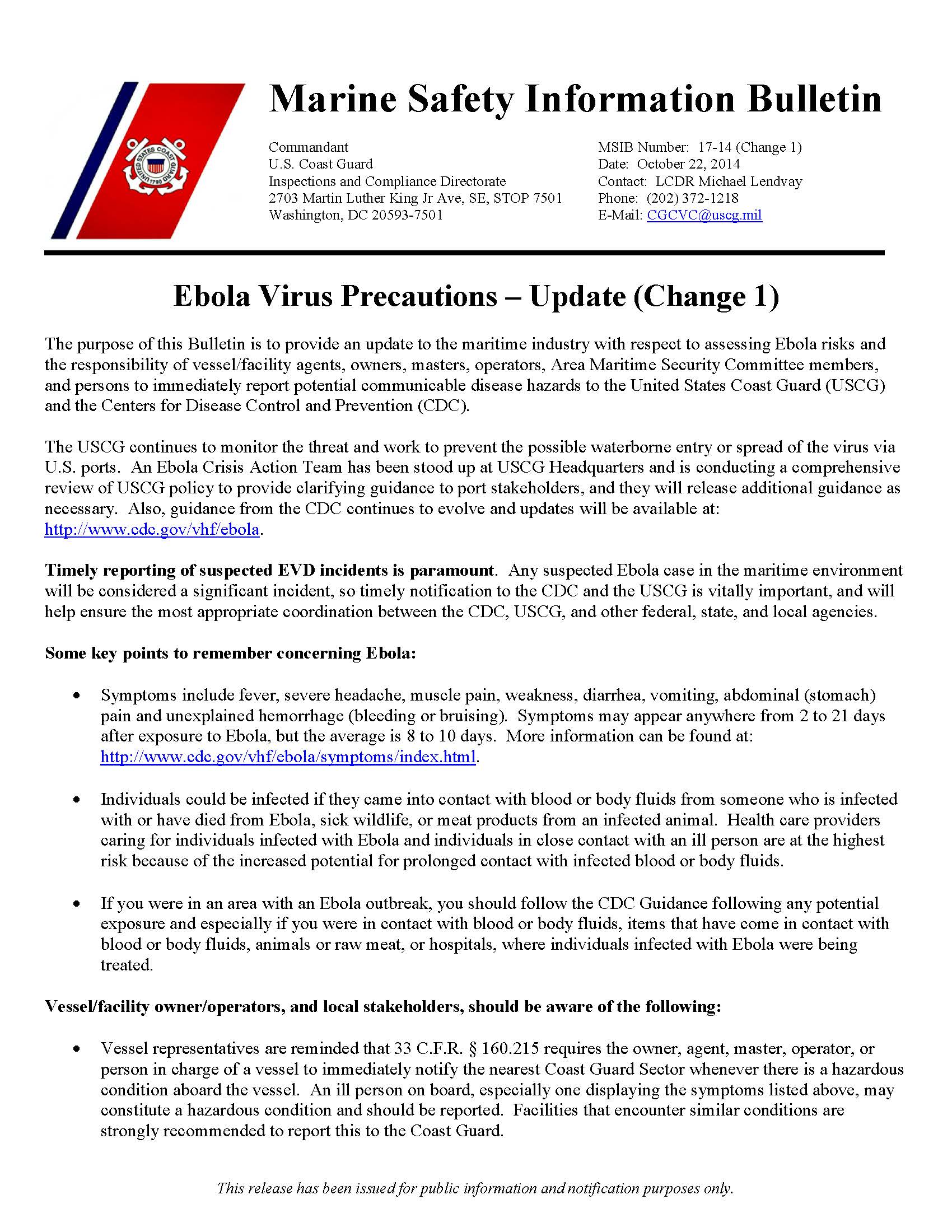
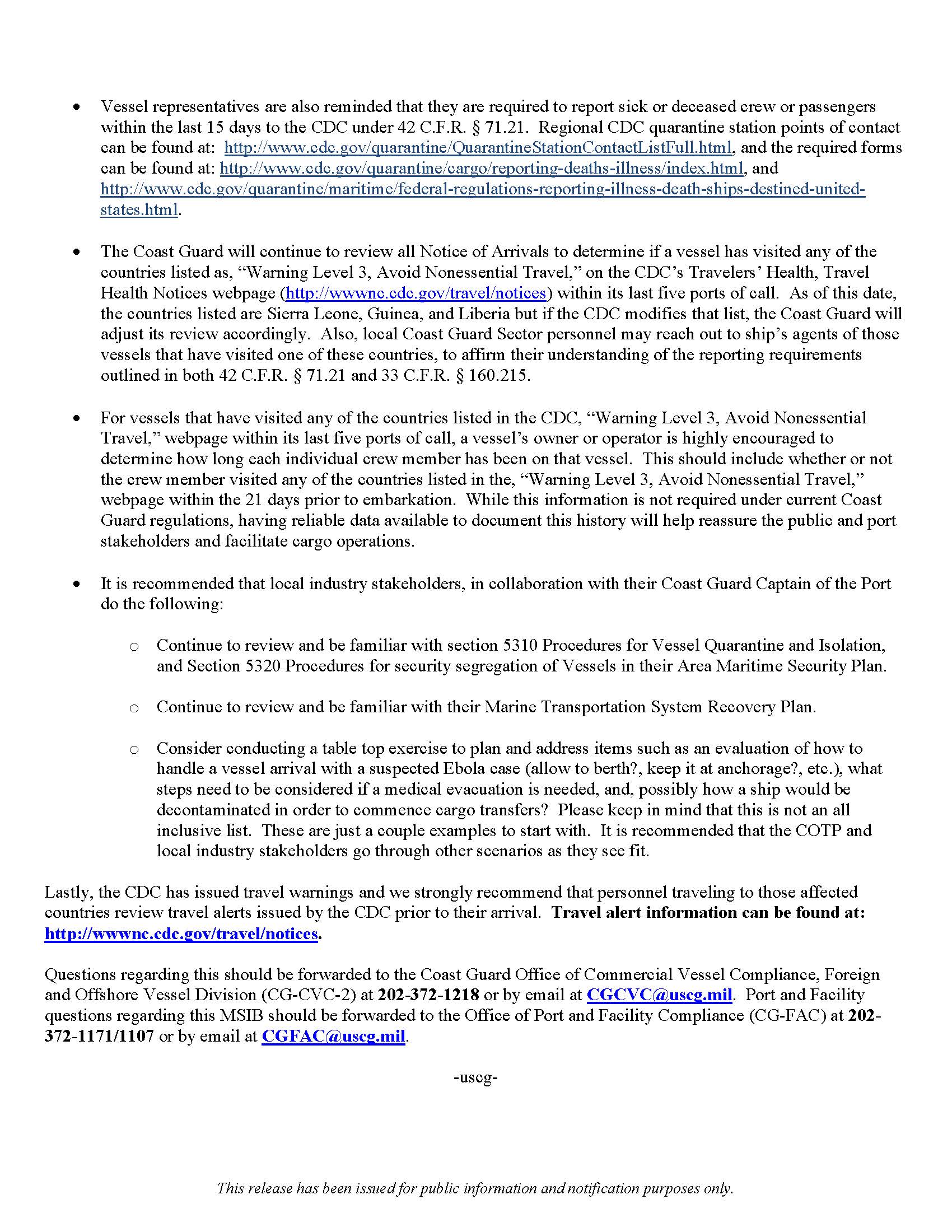
United States Coast Guard Ebola Virus Precautions - October 17, 2014
Safest Catch dot Net ~ SafestCatch.Net
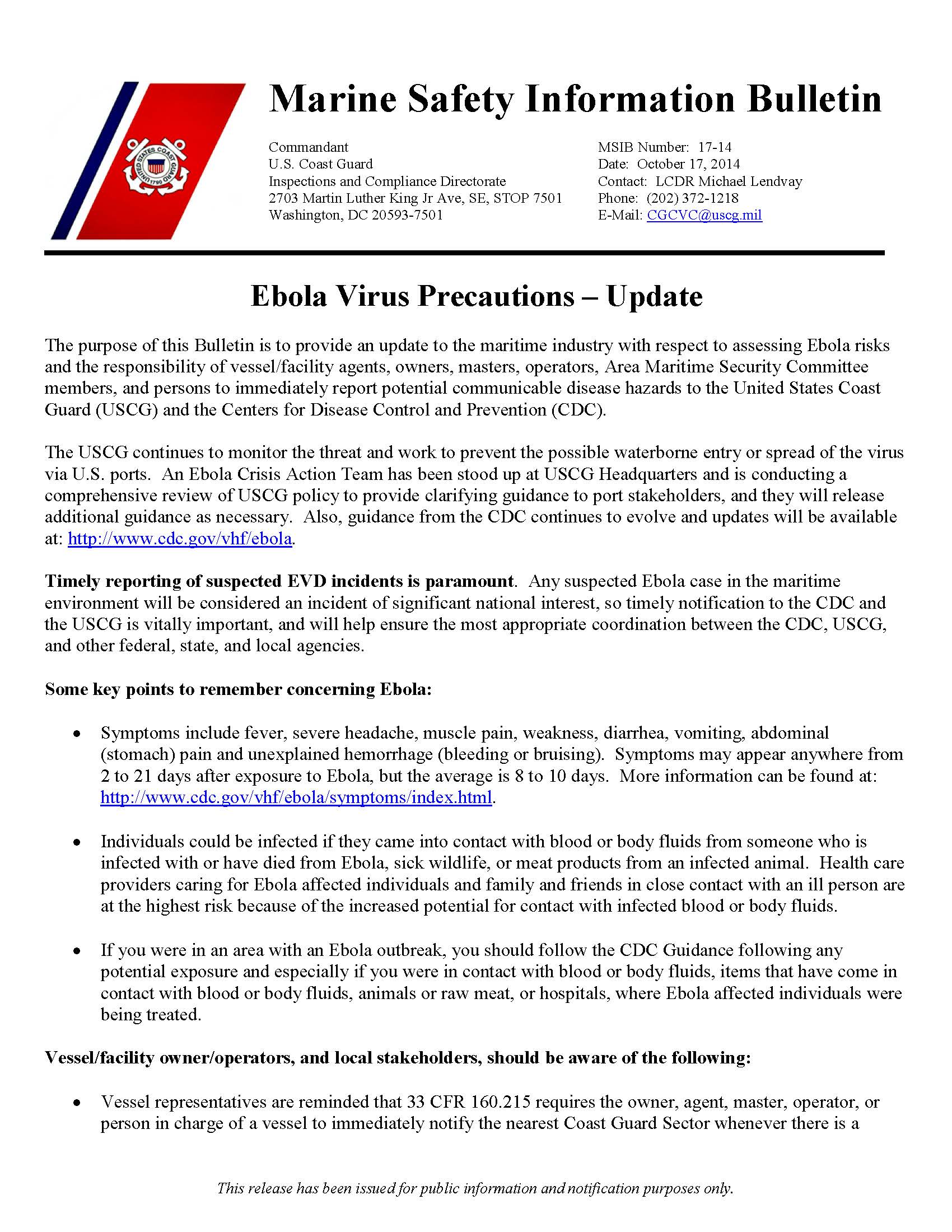
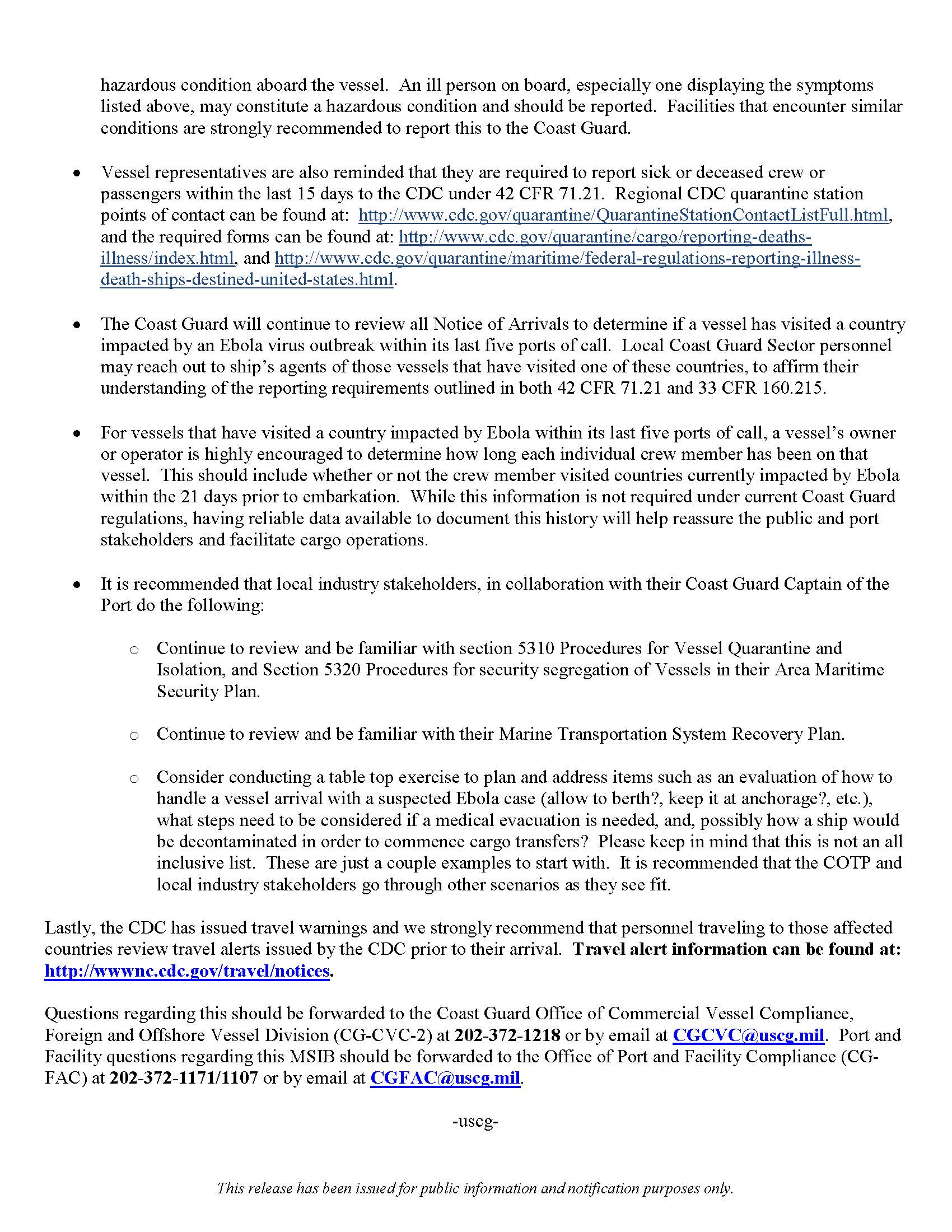
Healthforce Ebola 10/9/2014
Safest Catch dot Net ~ SafestCatch.Net
